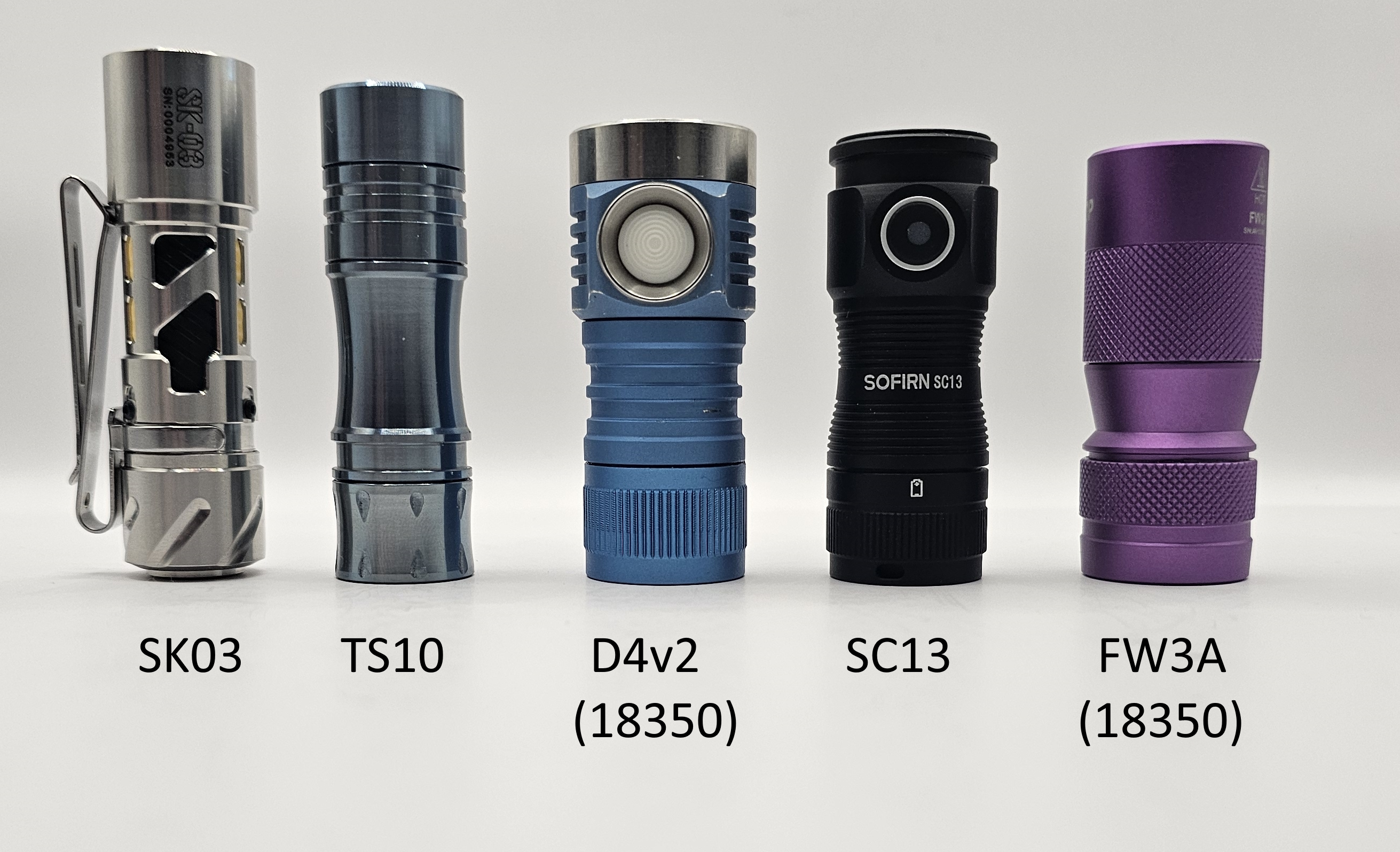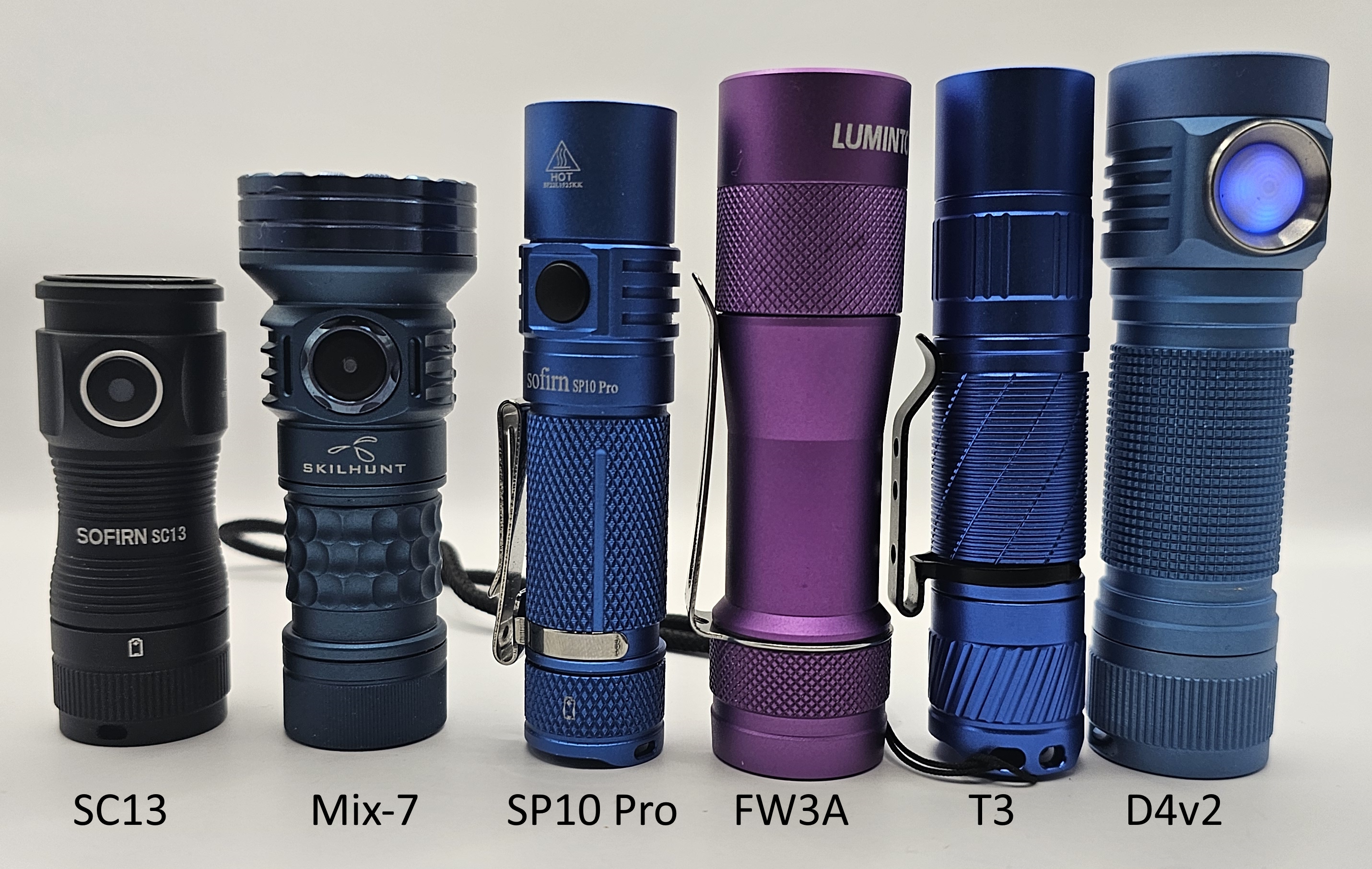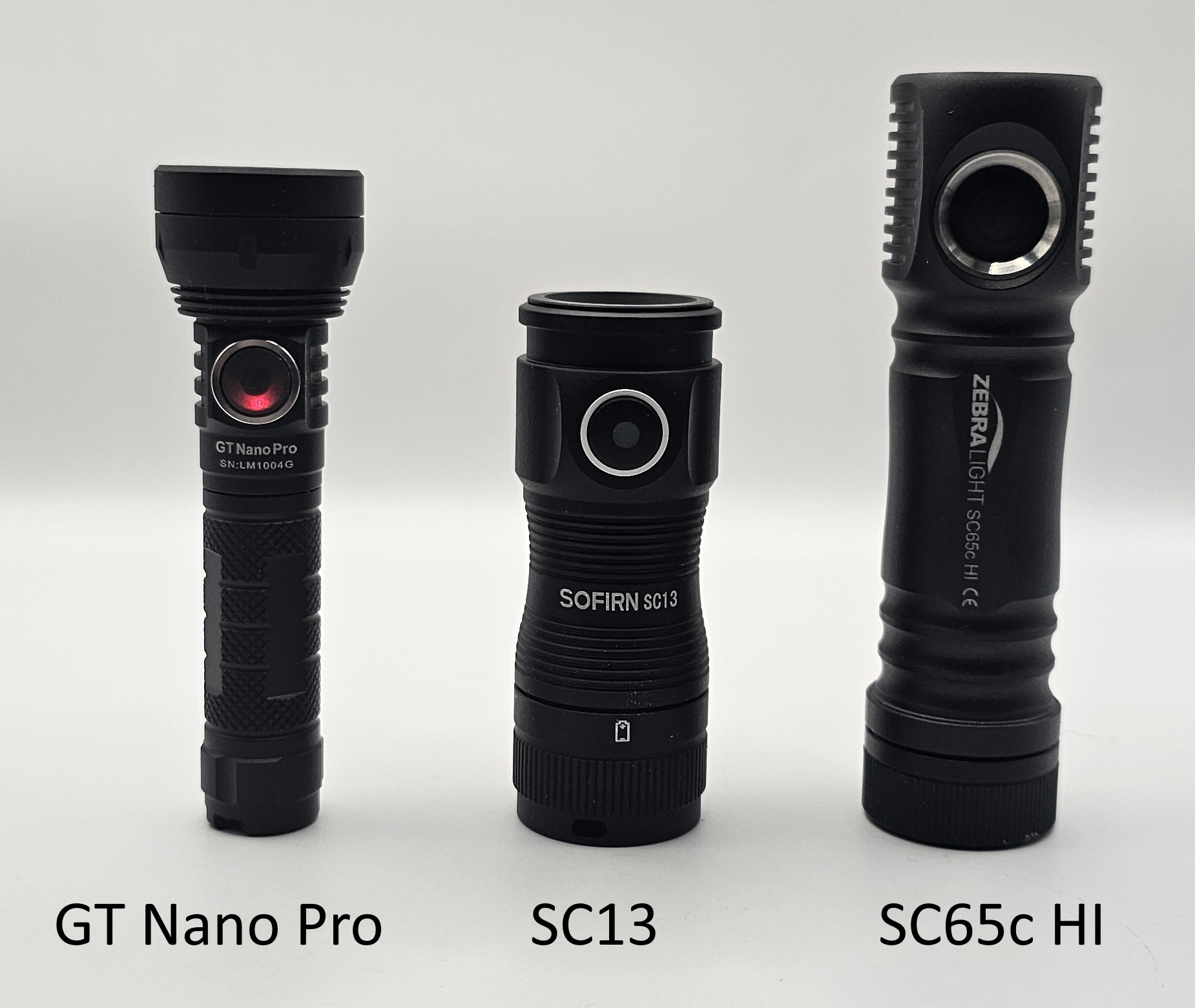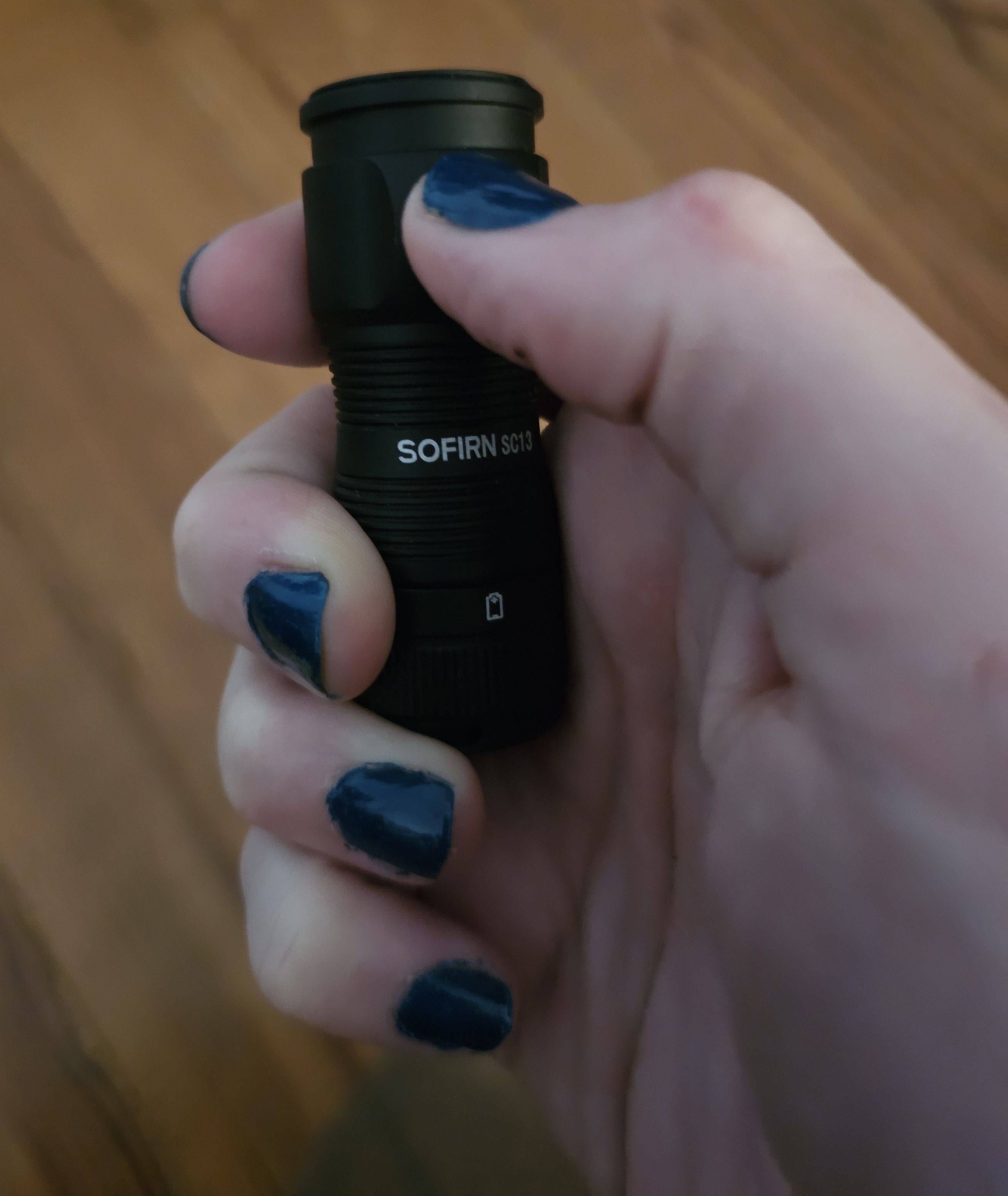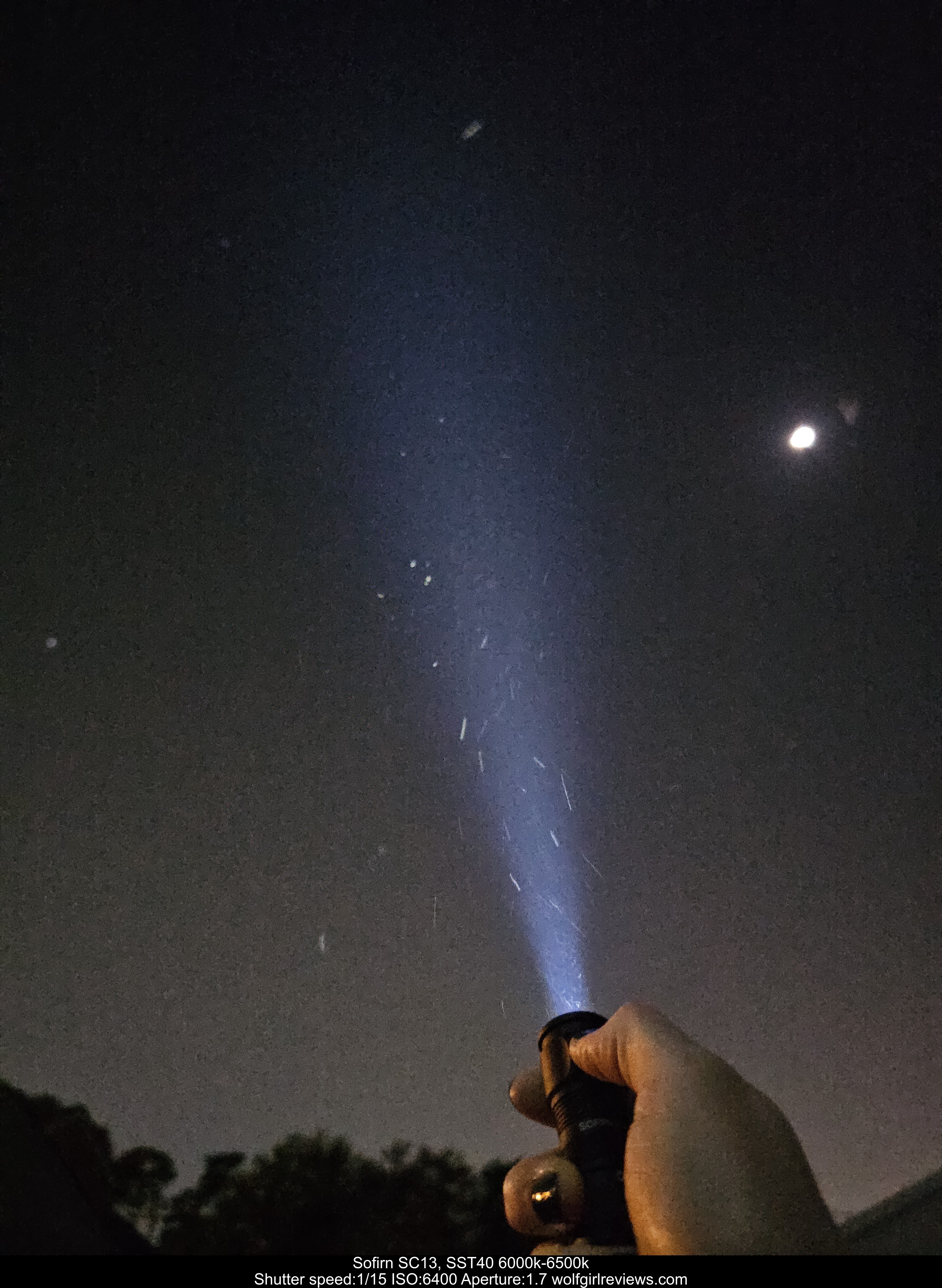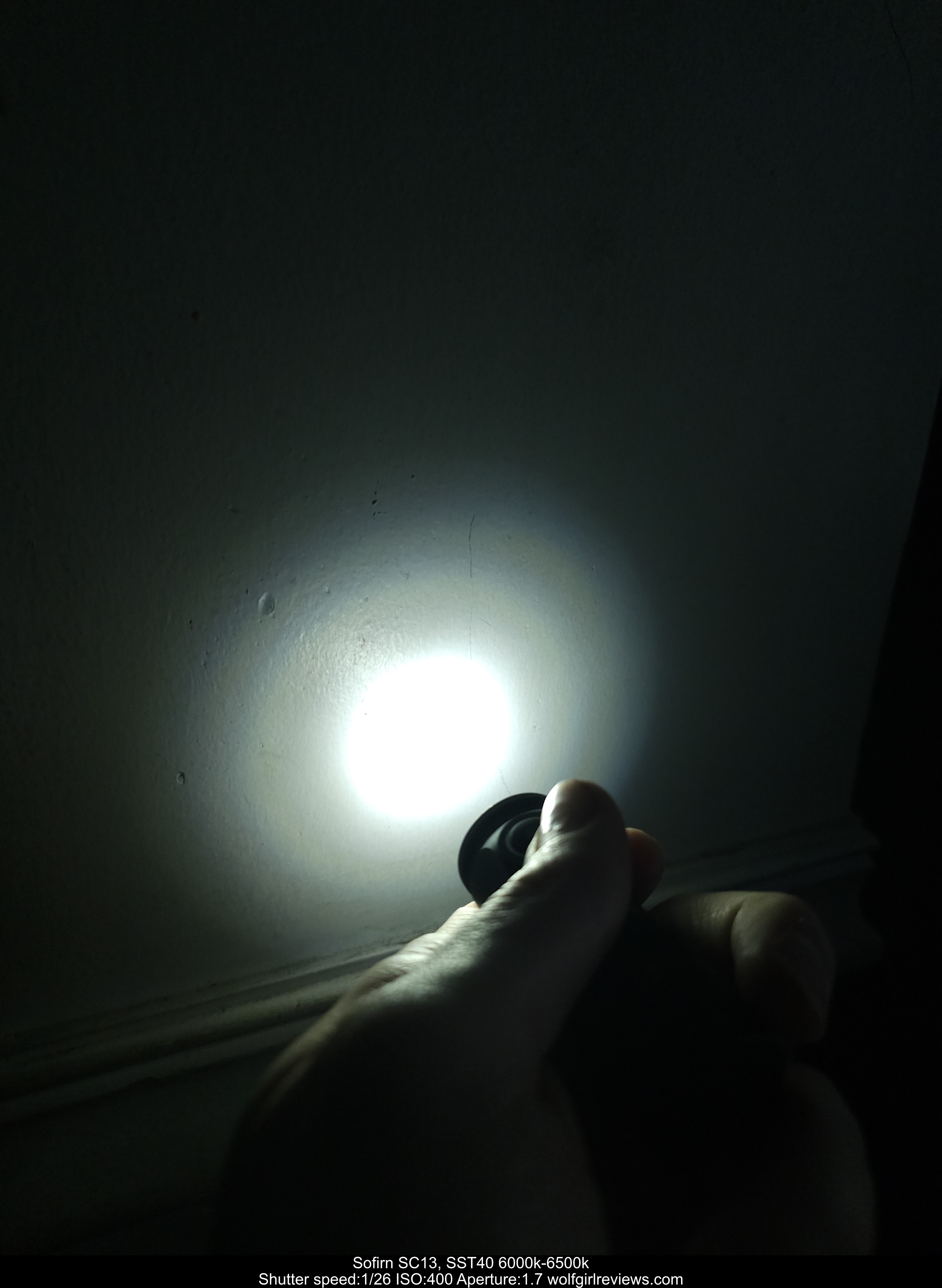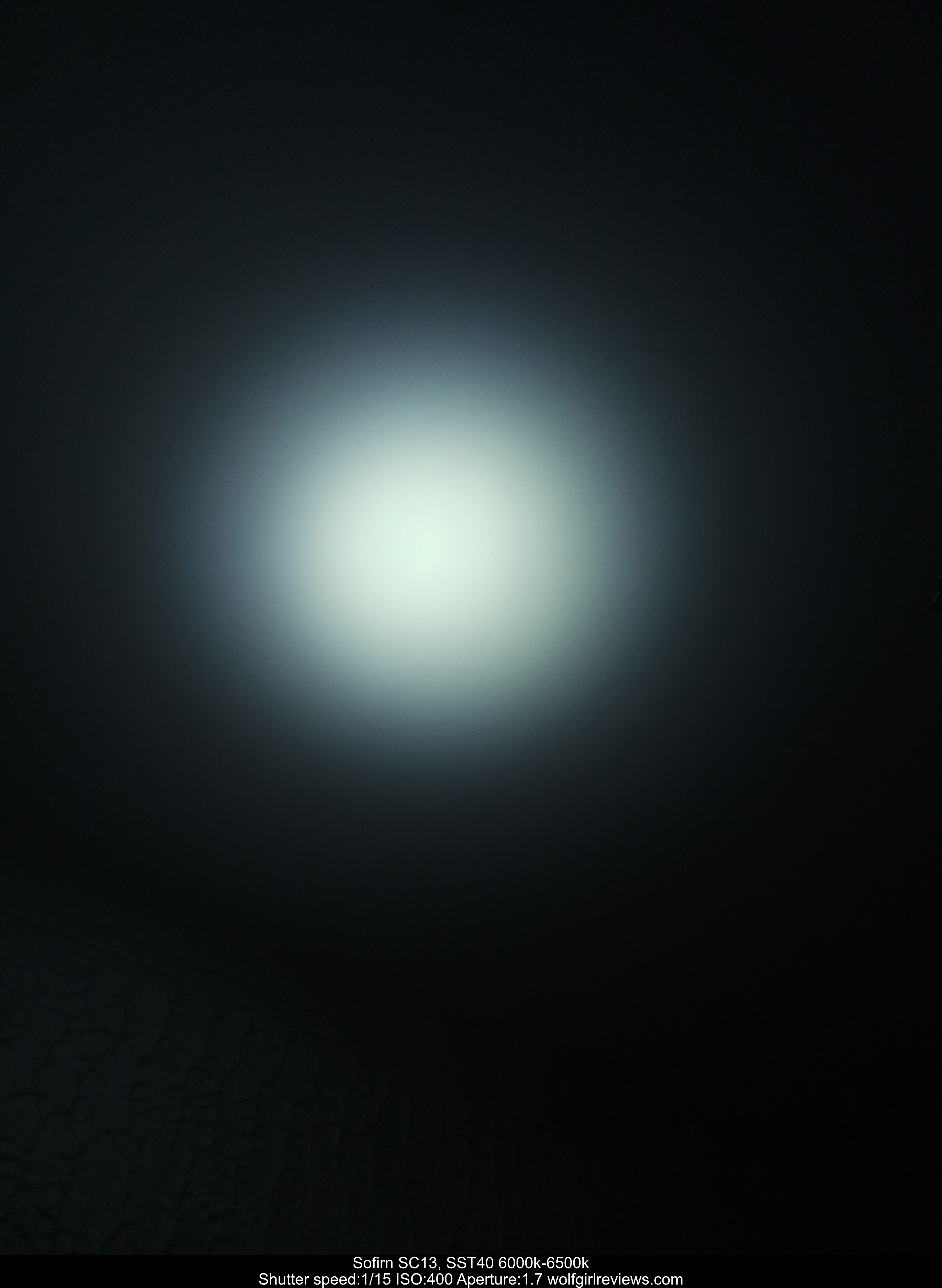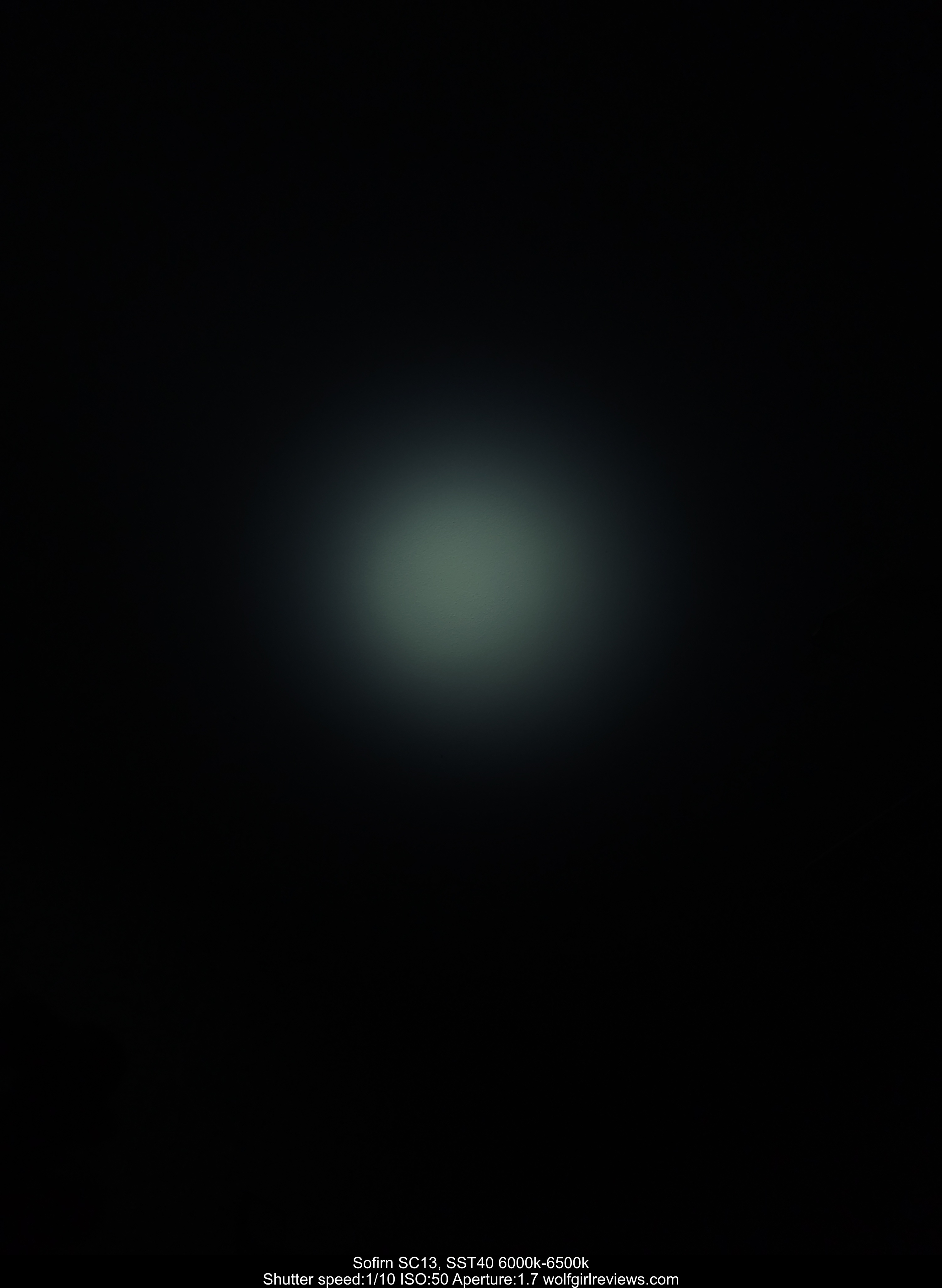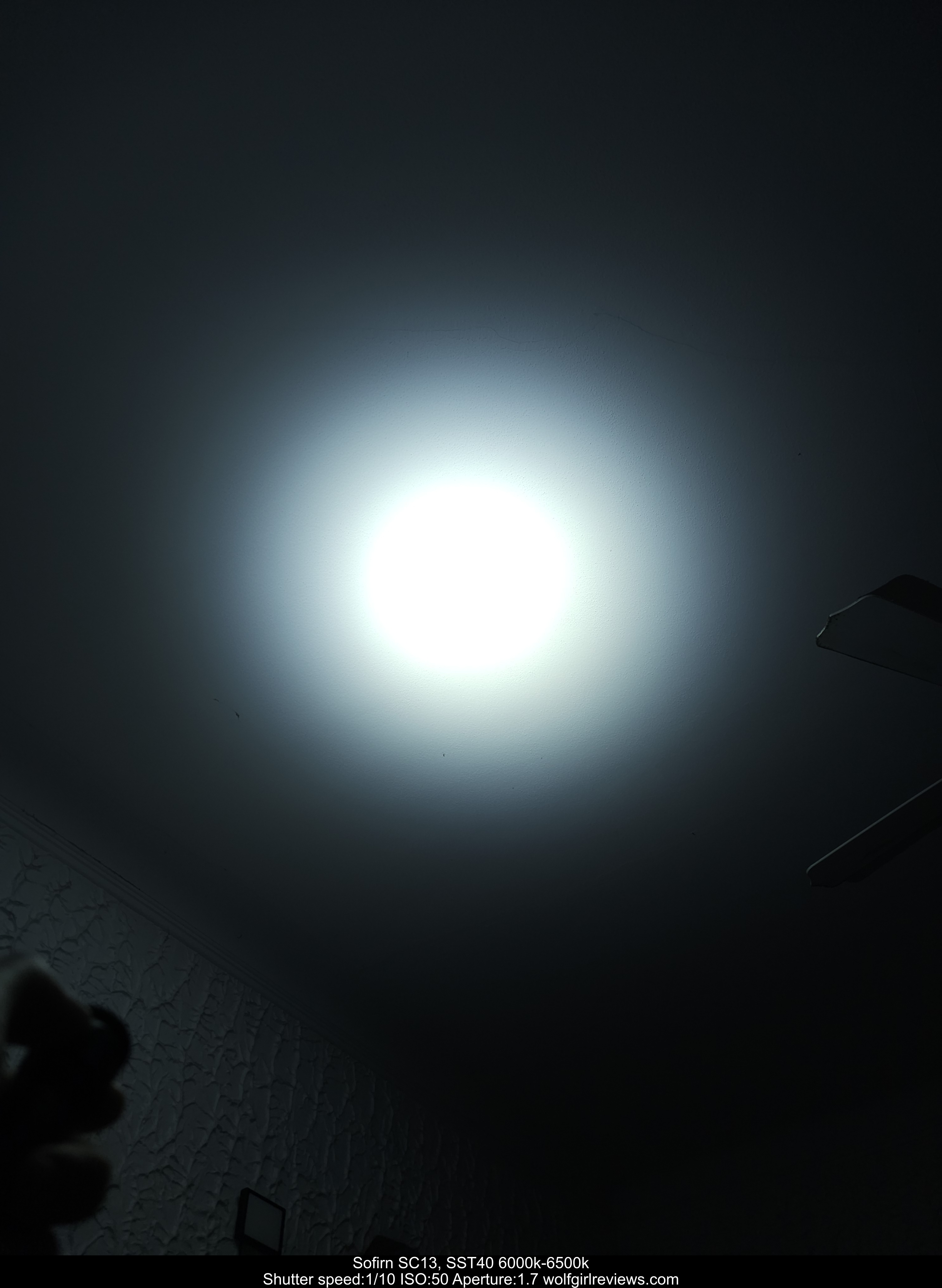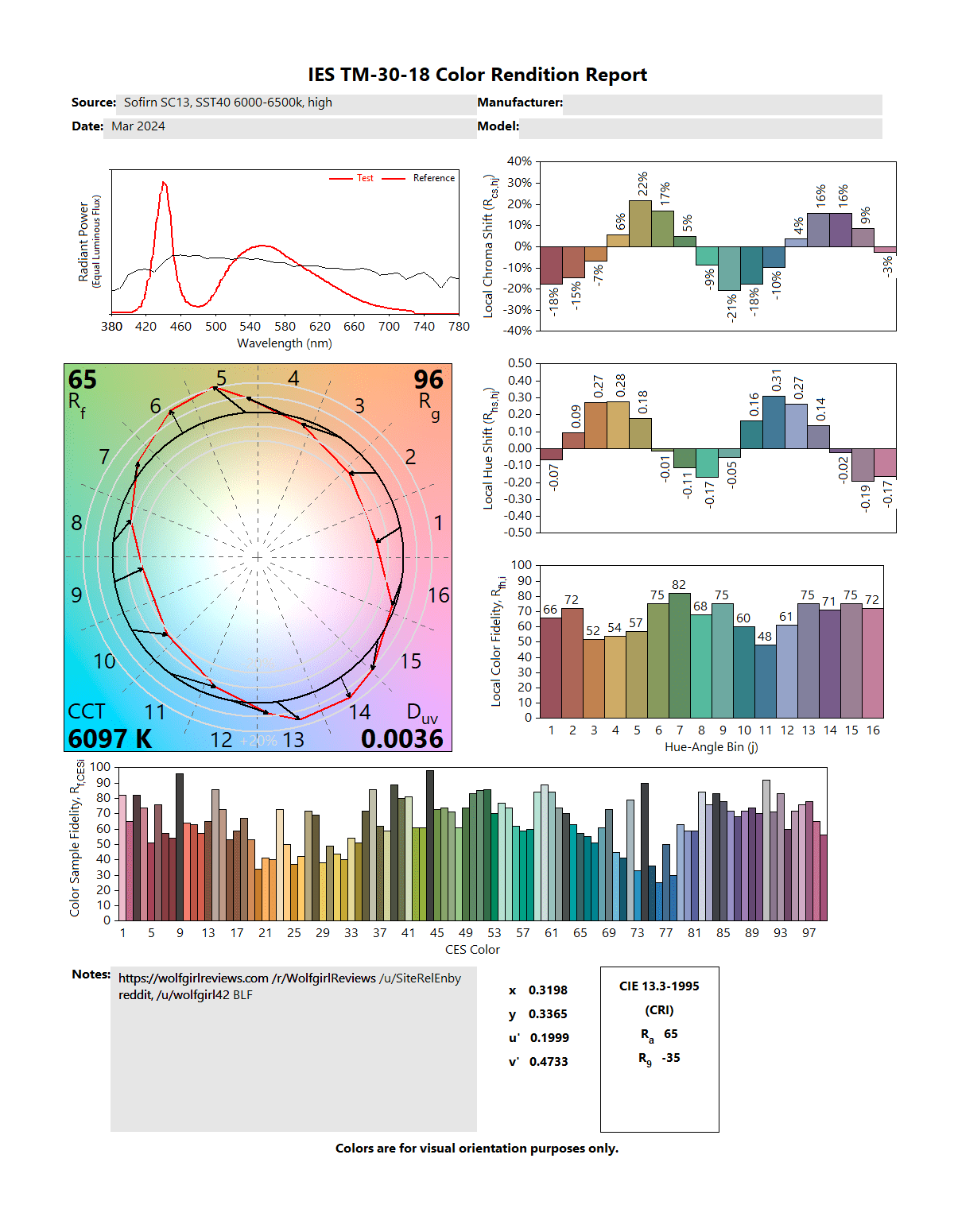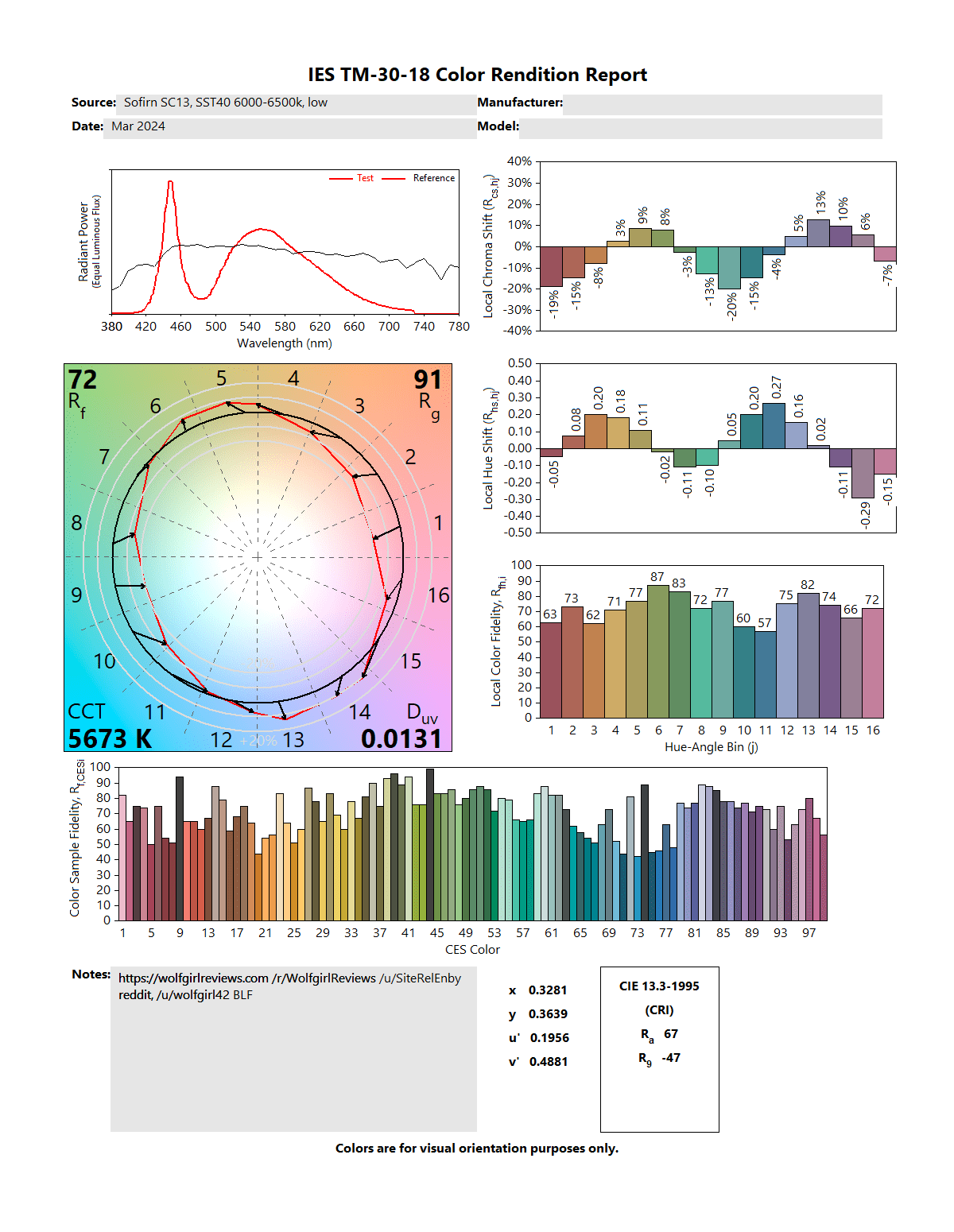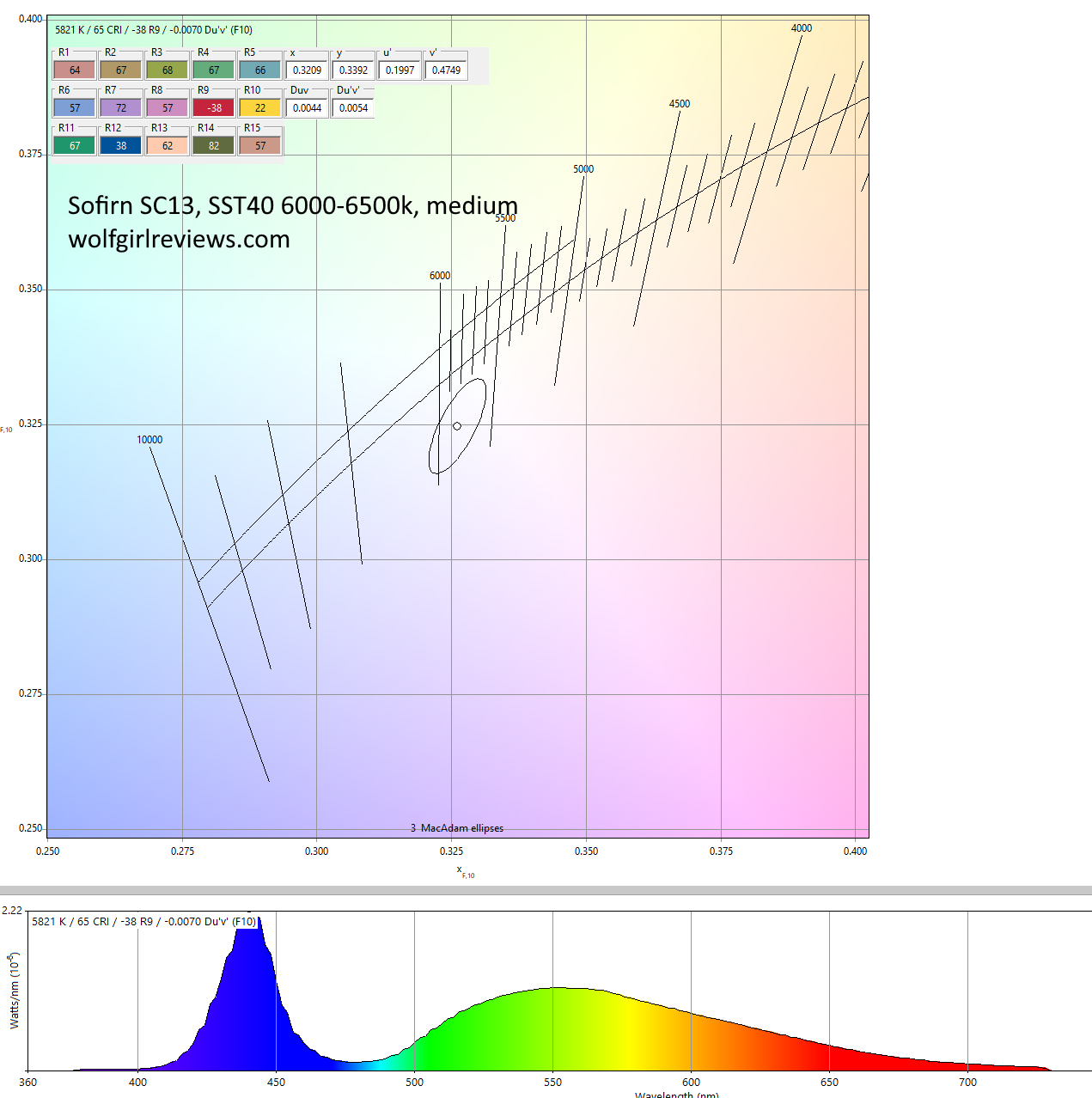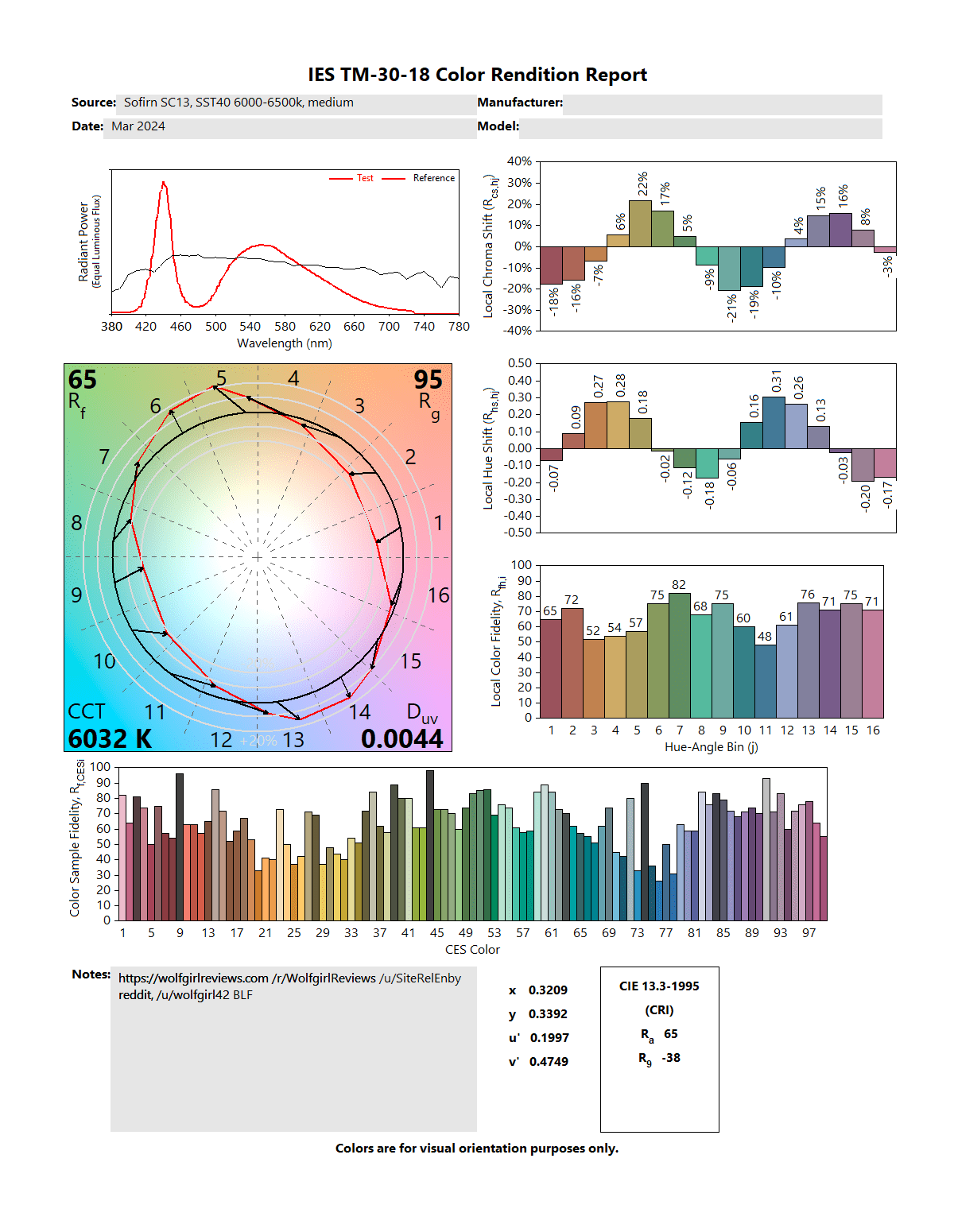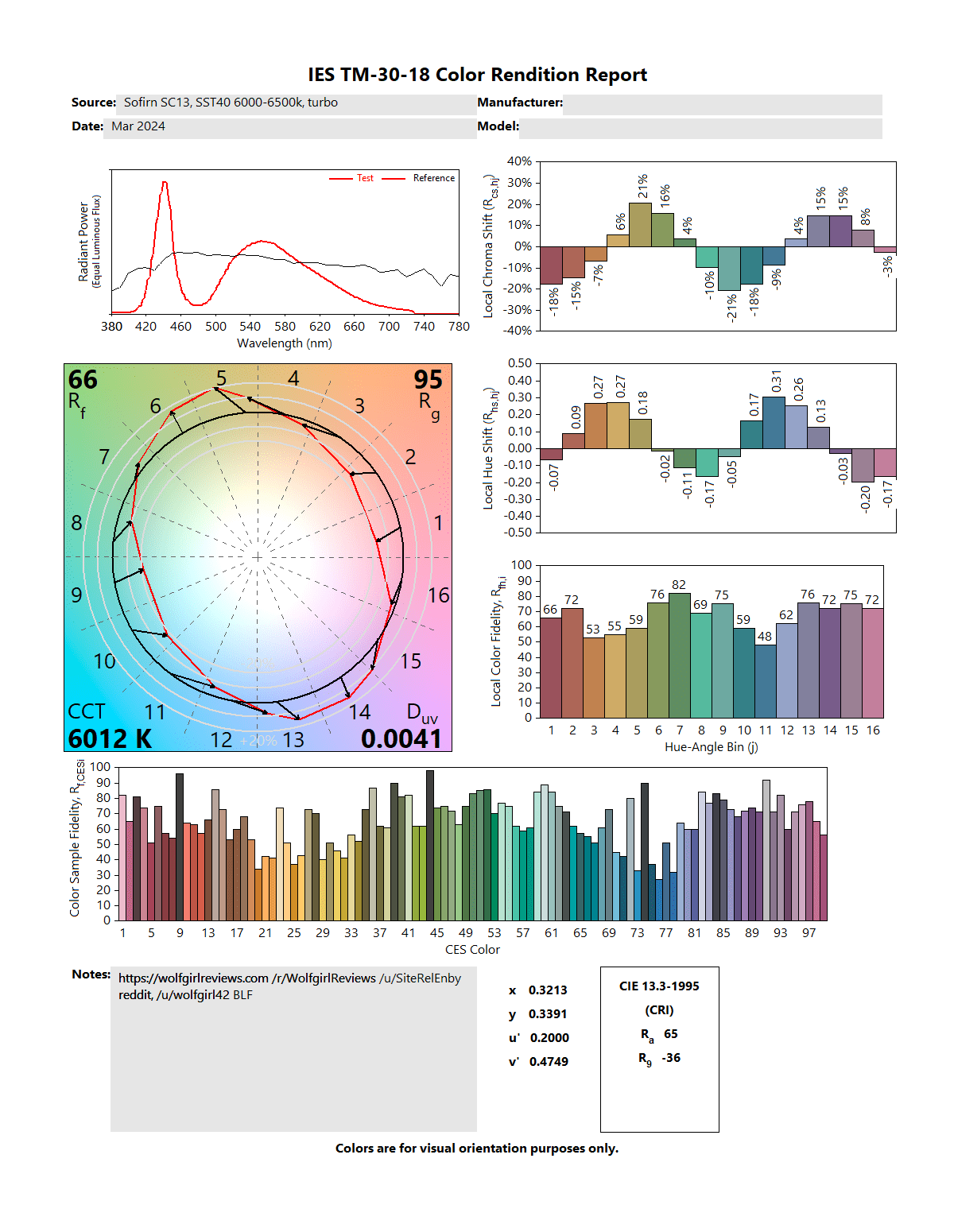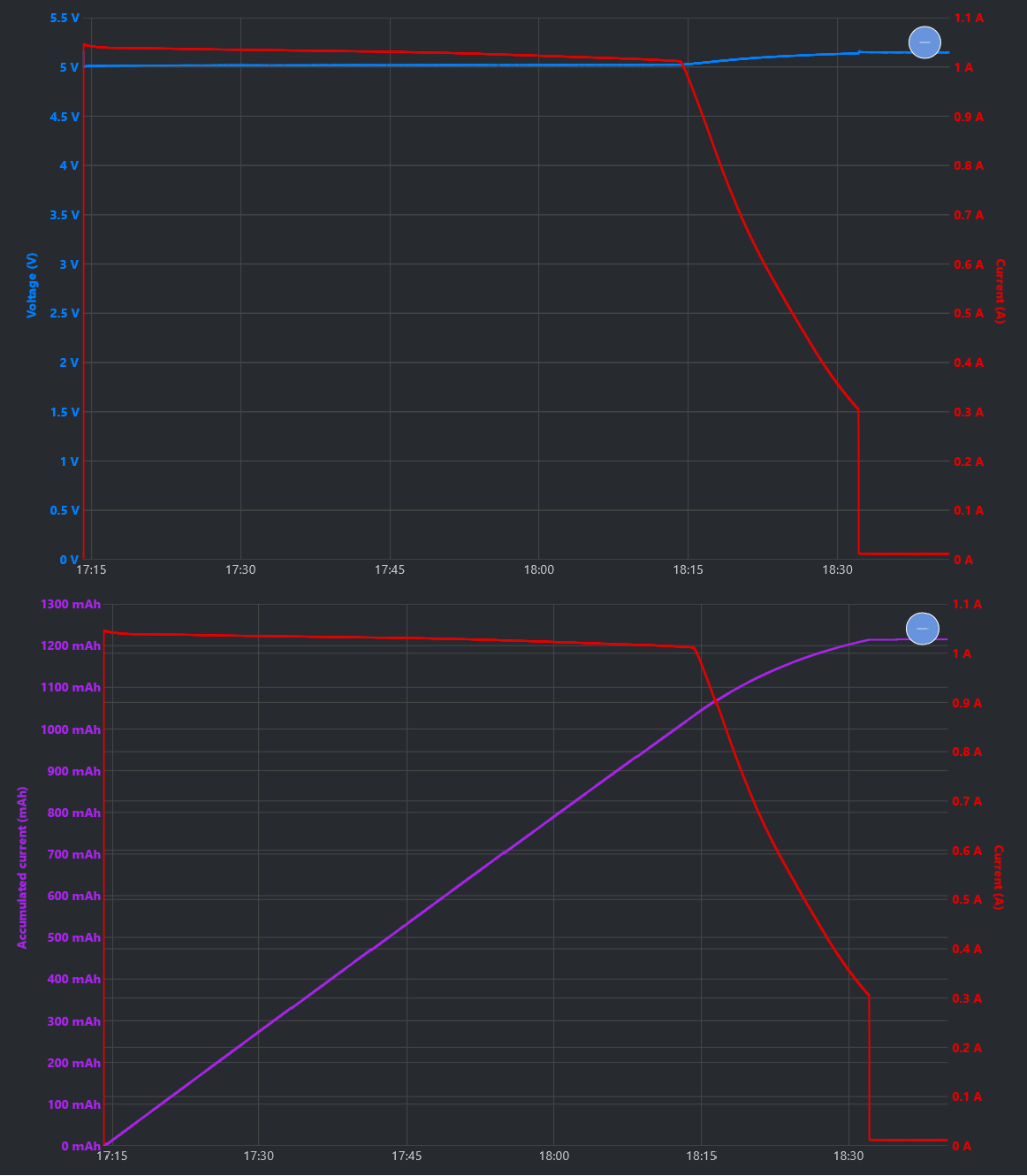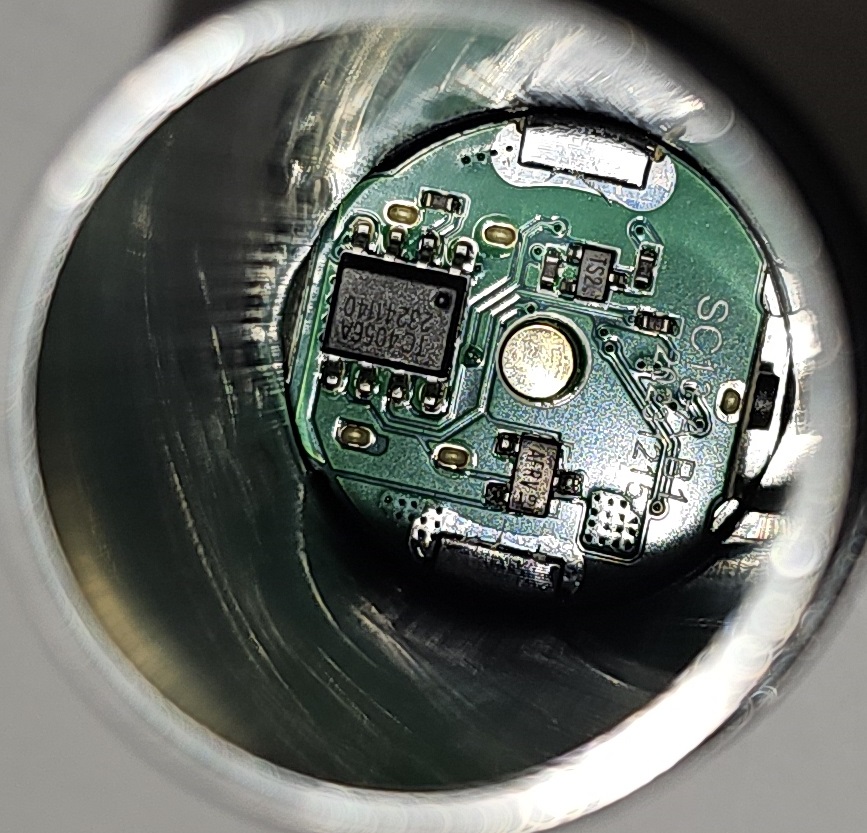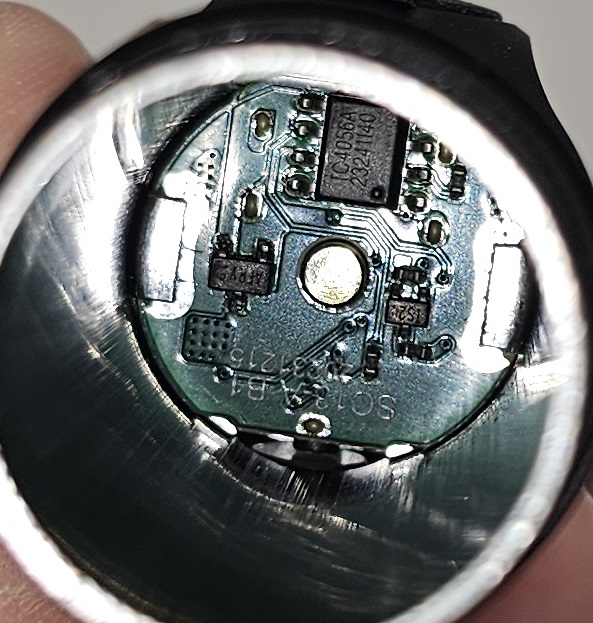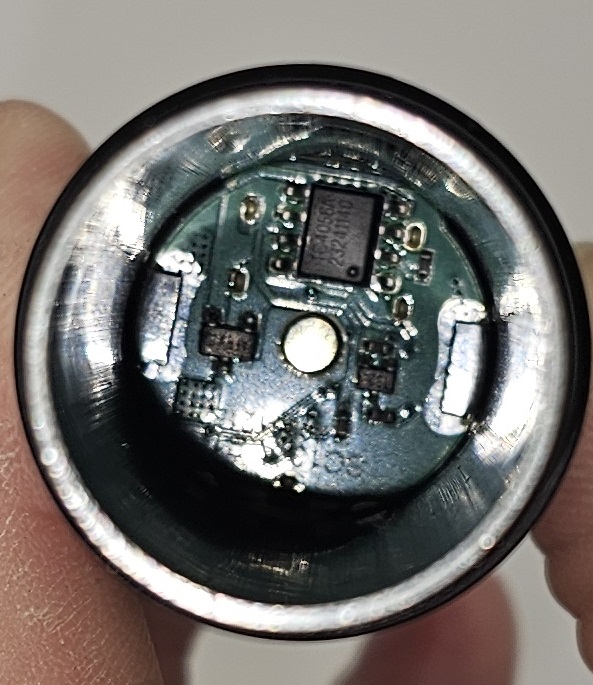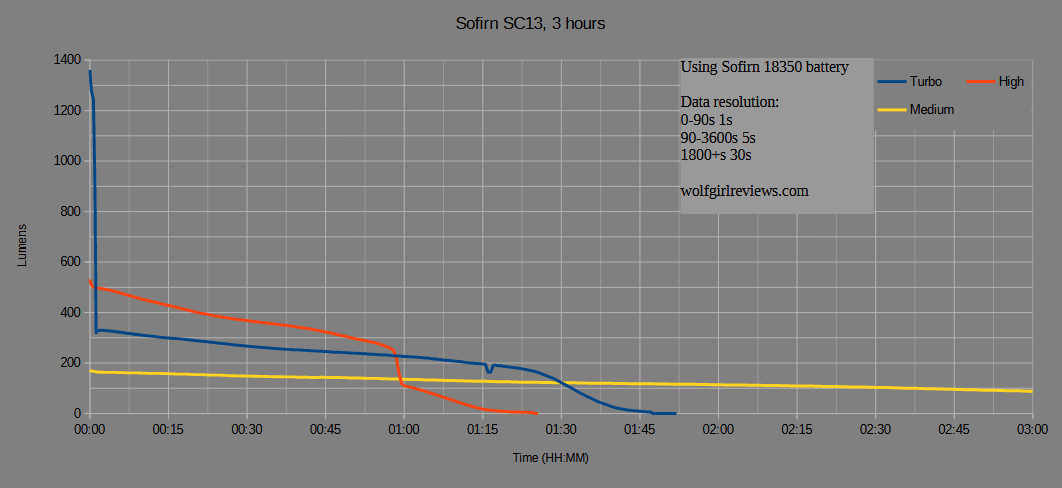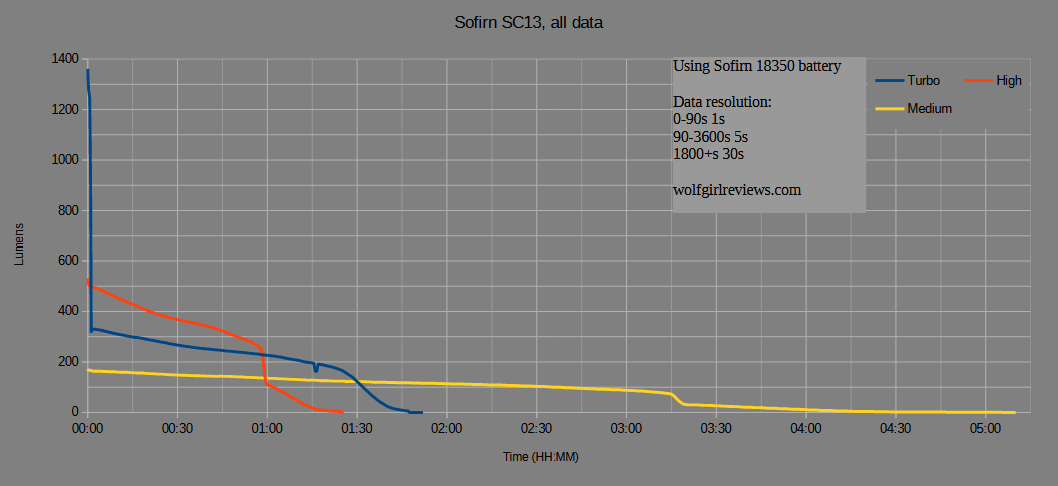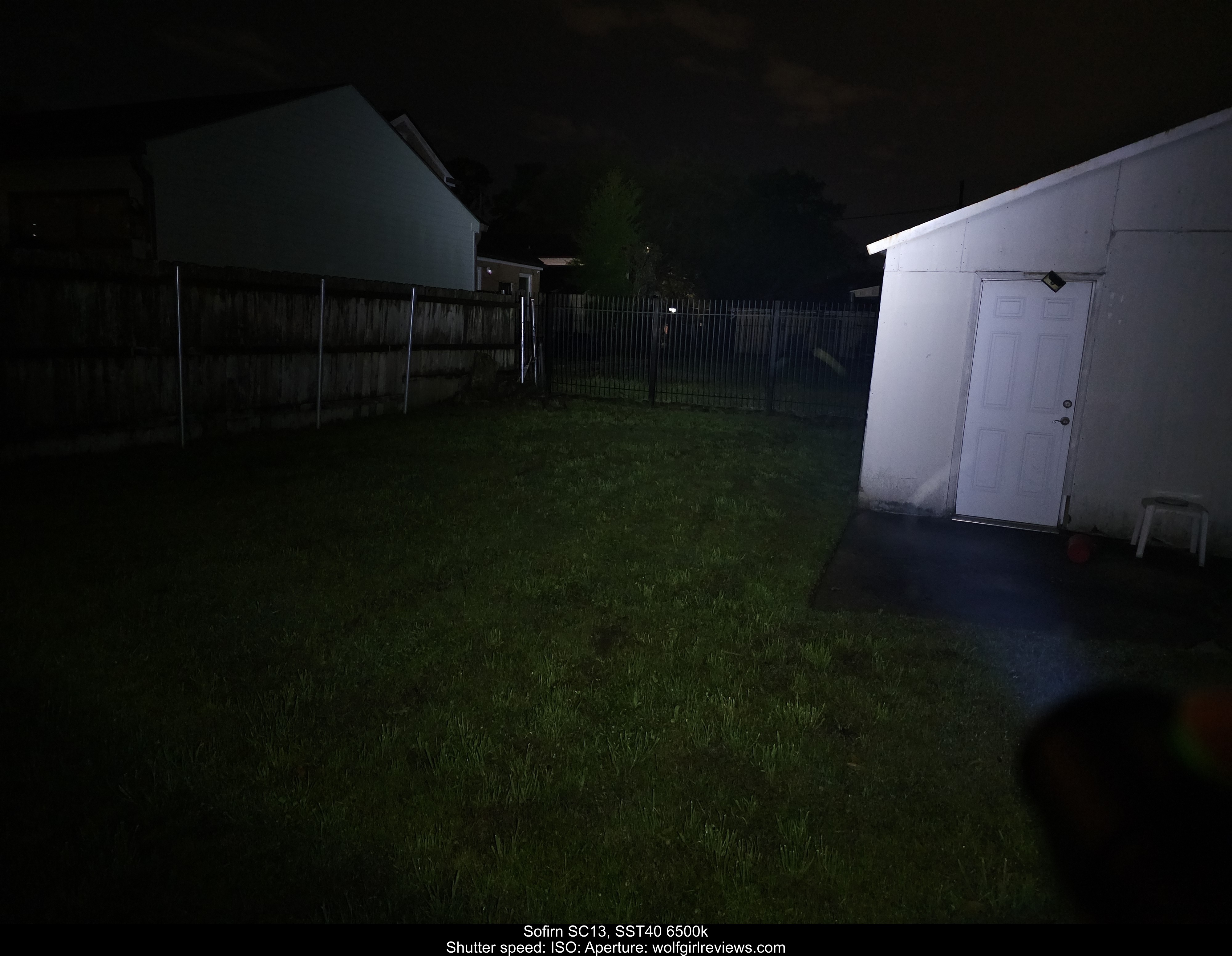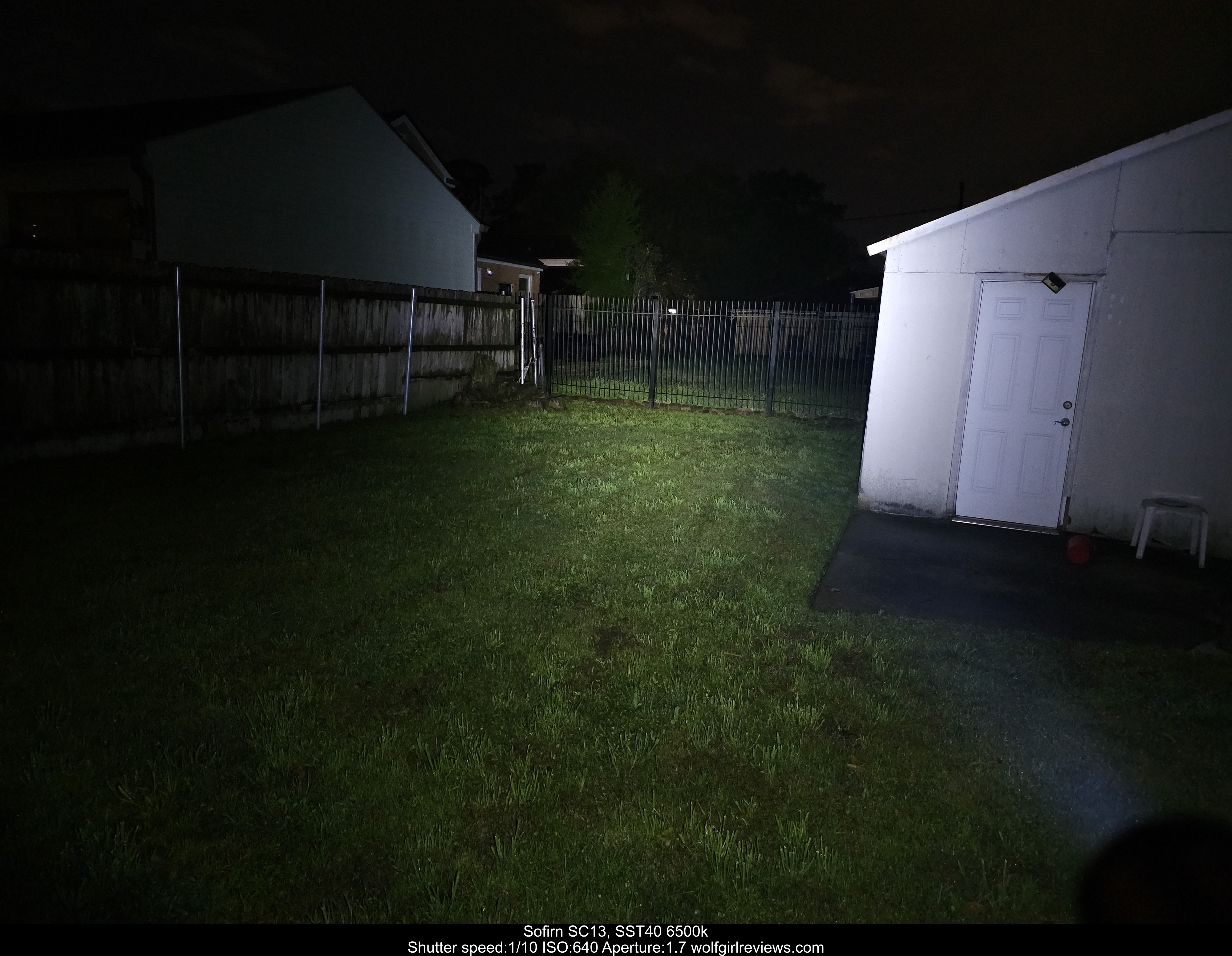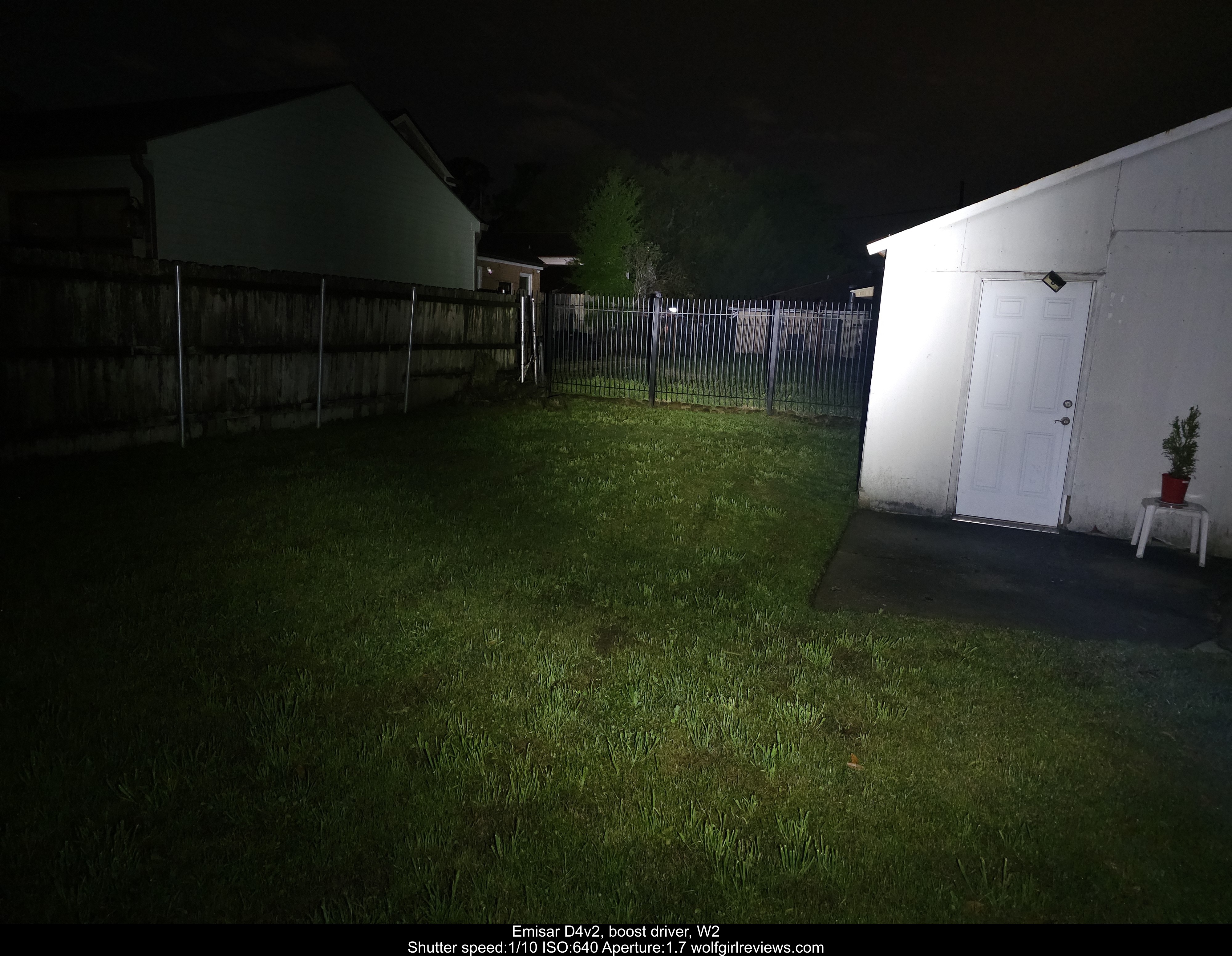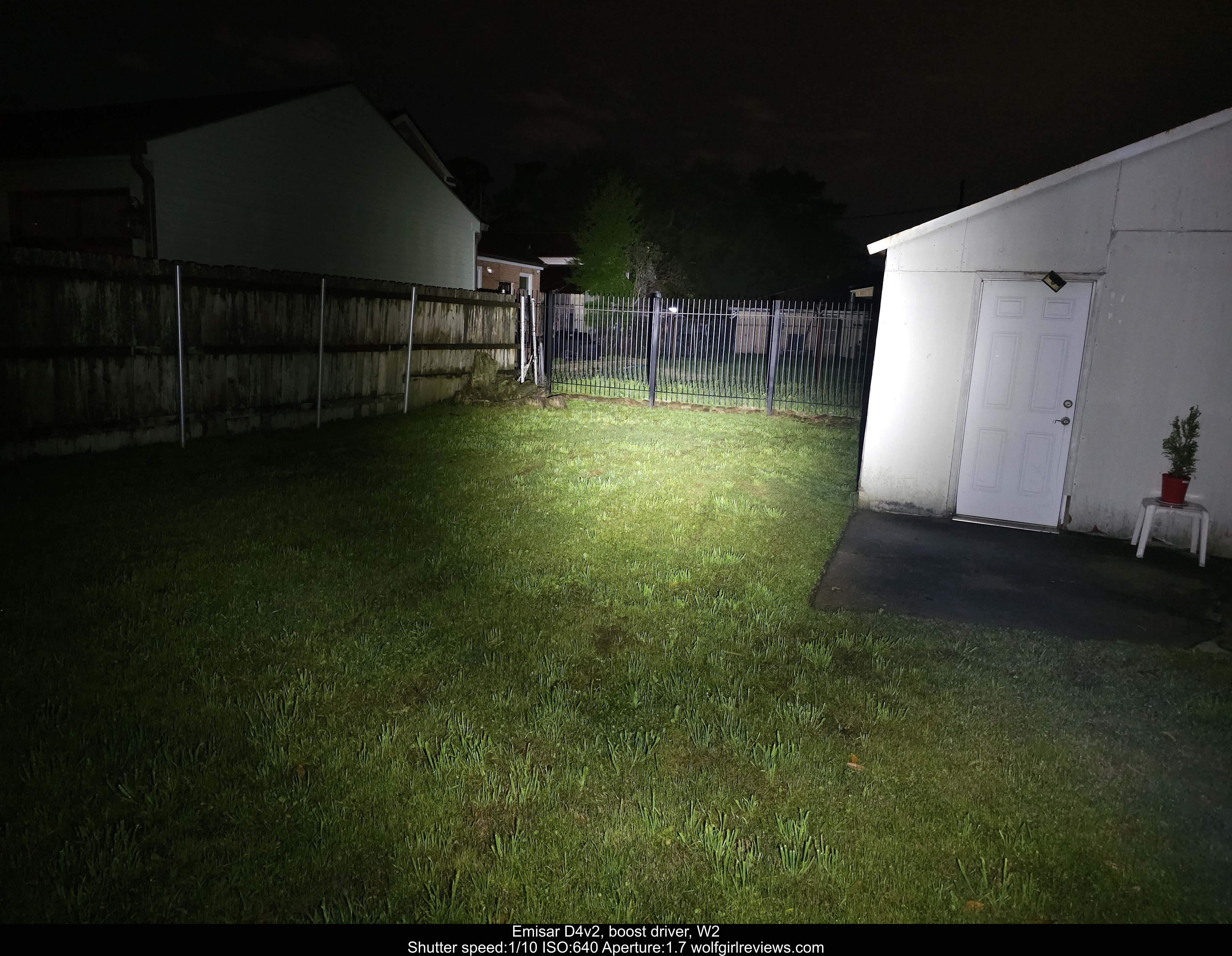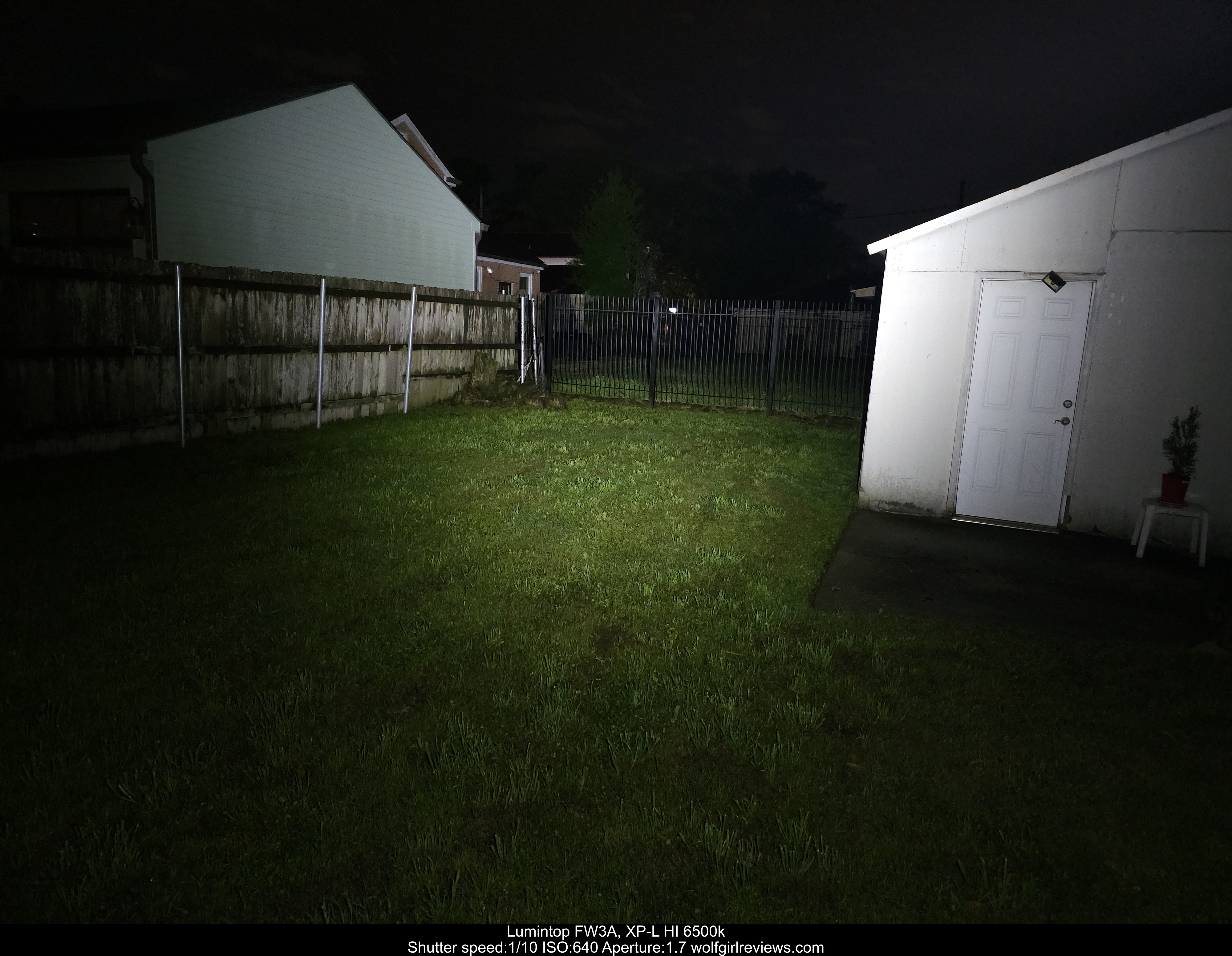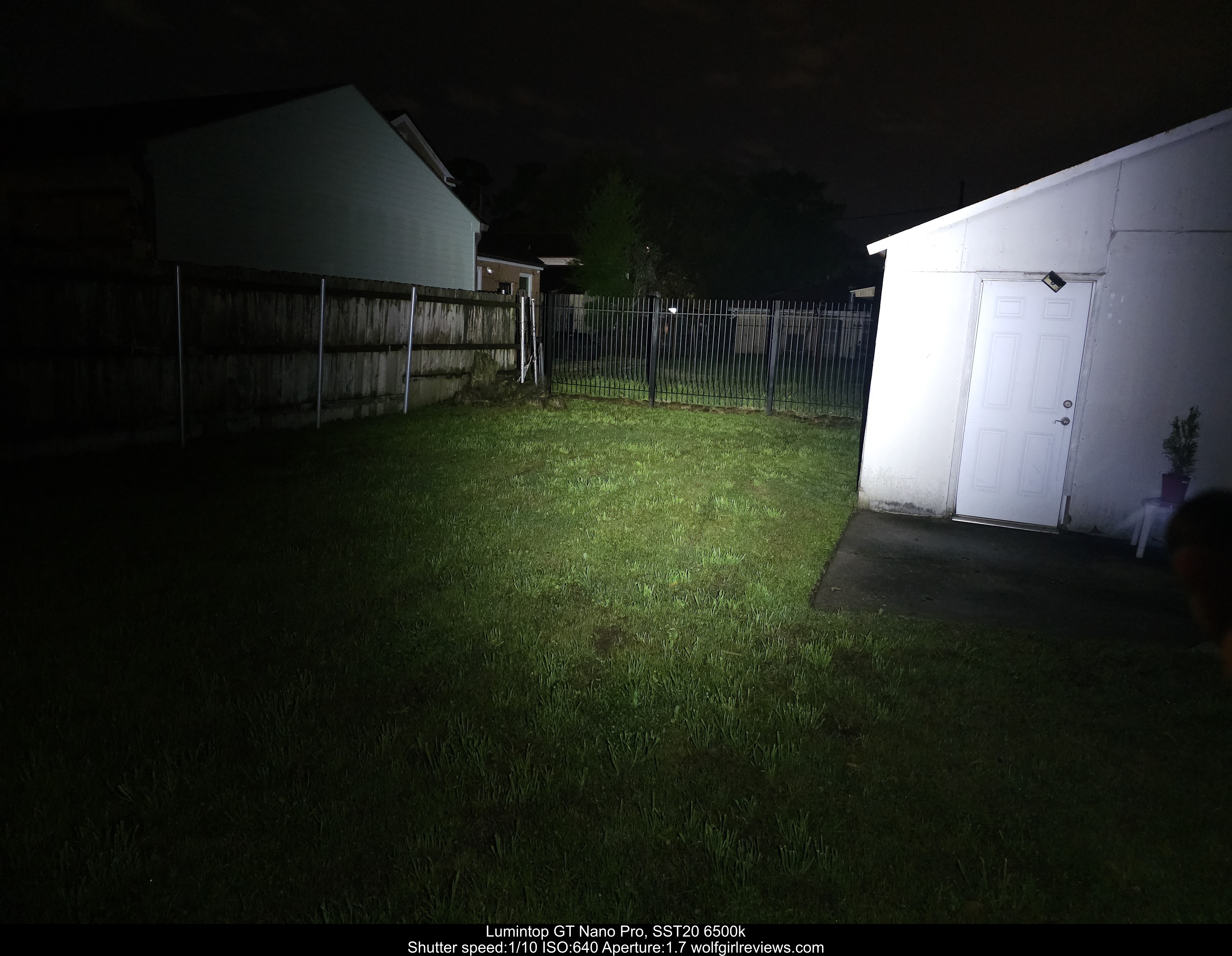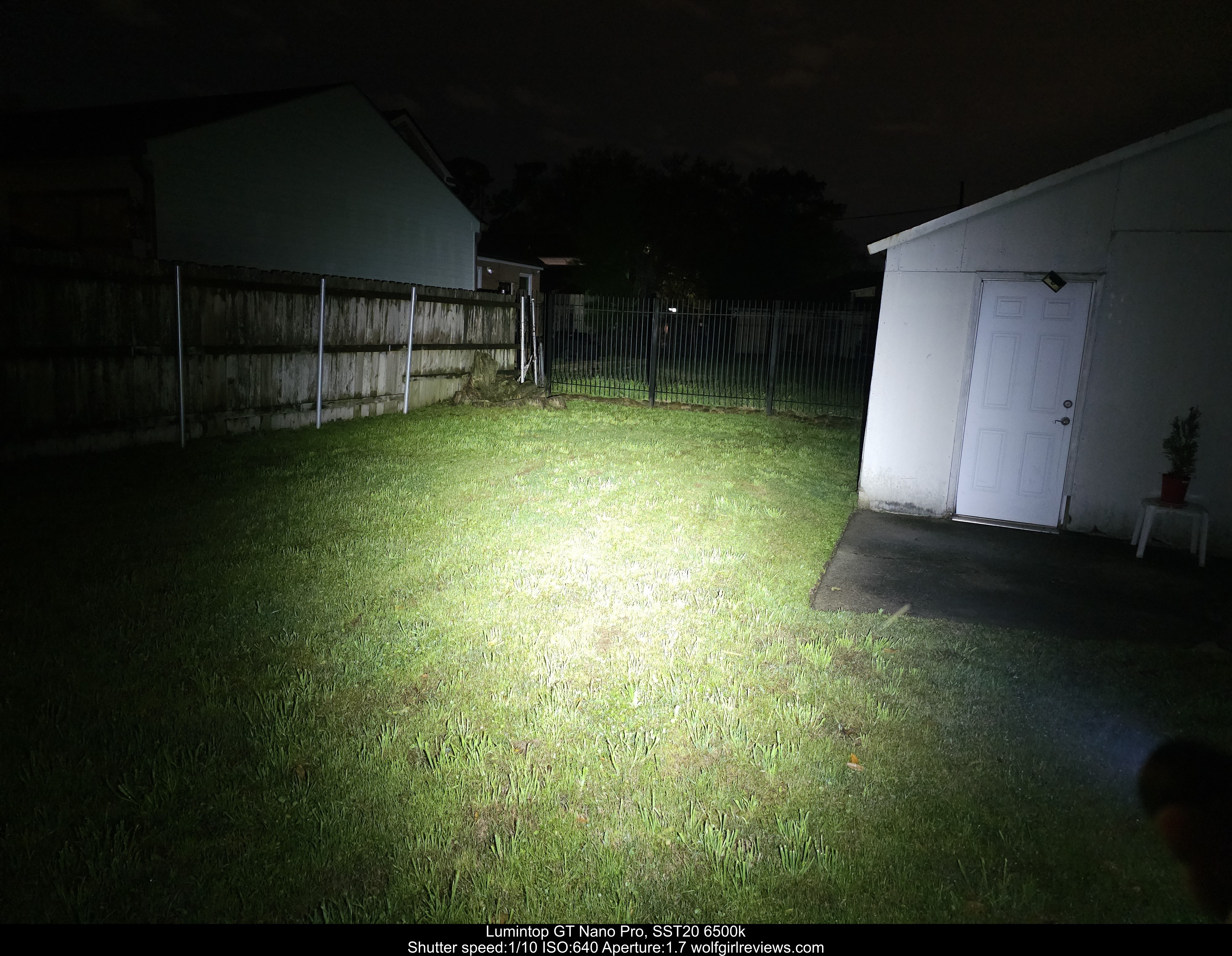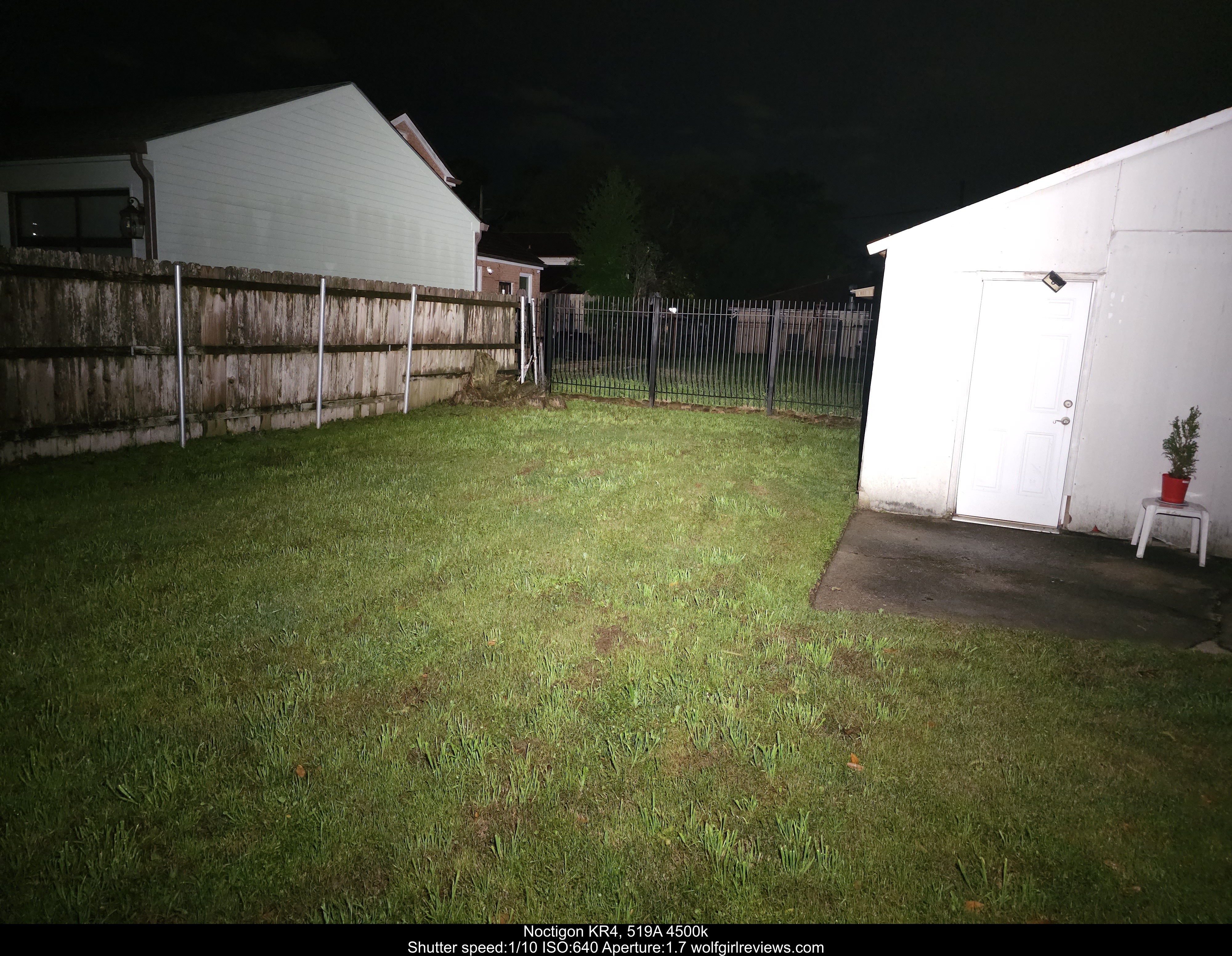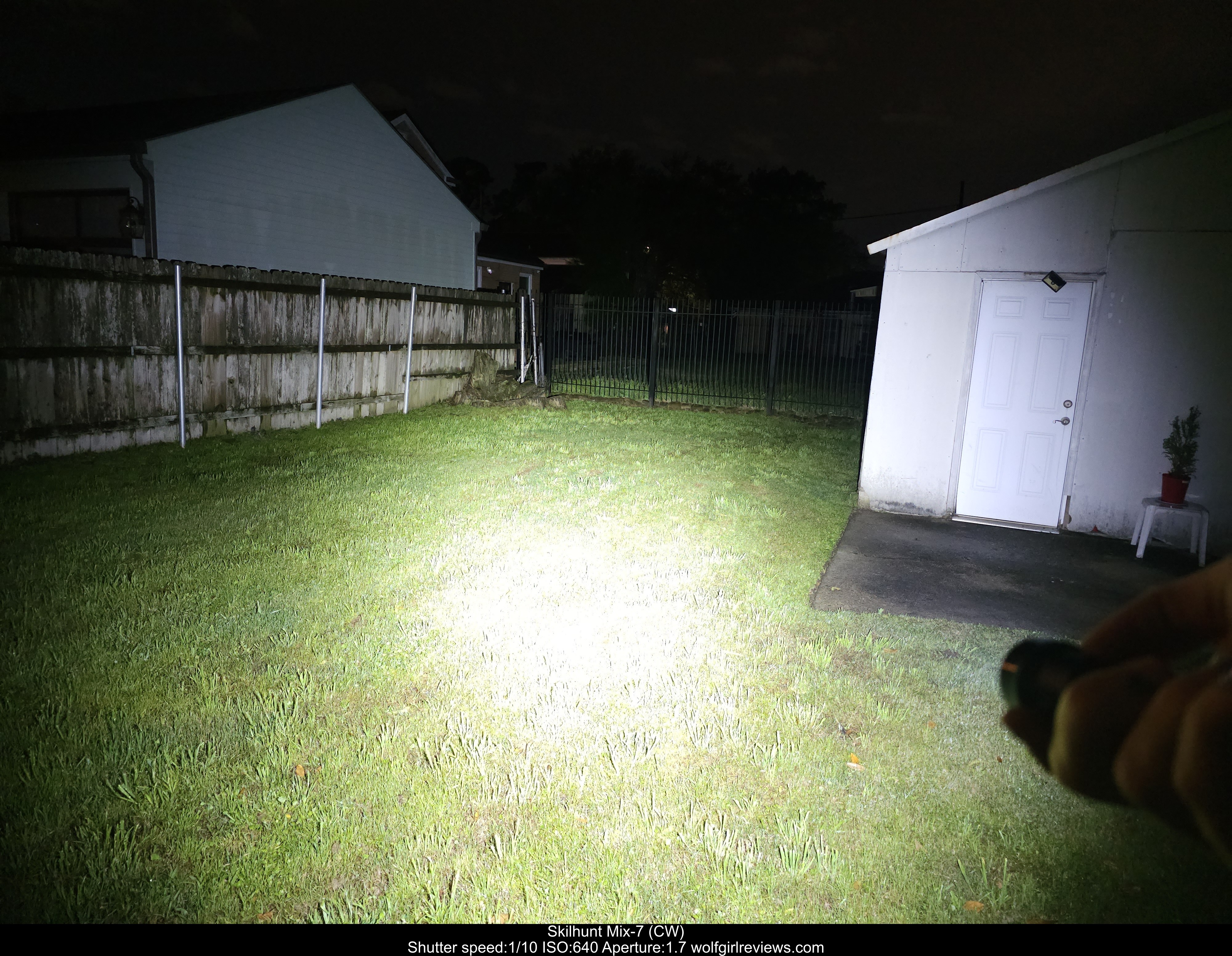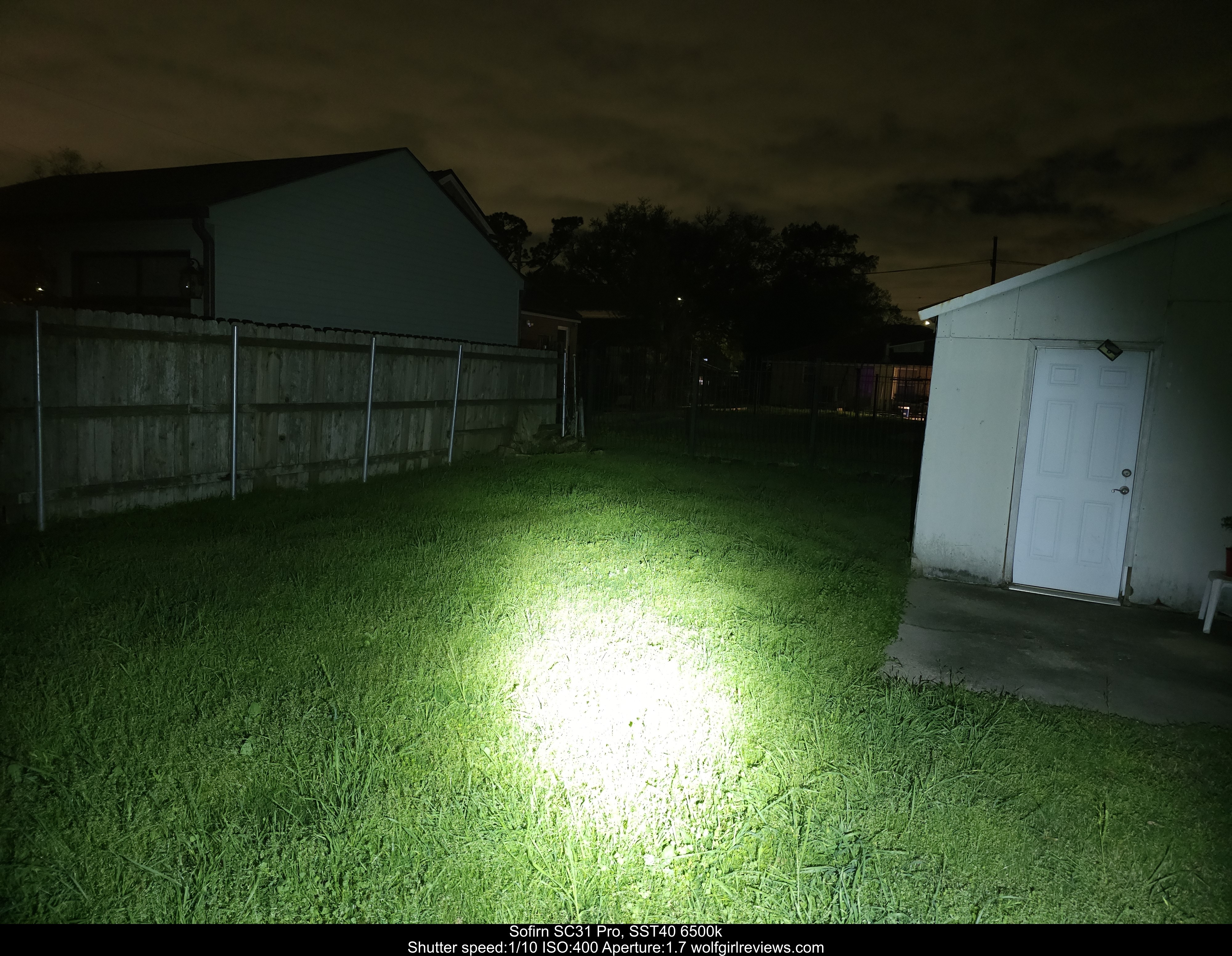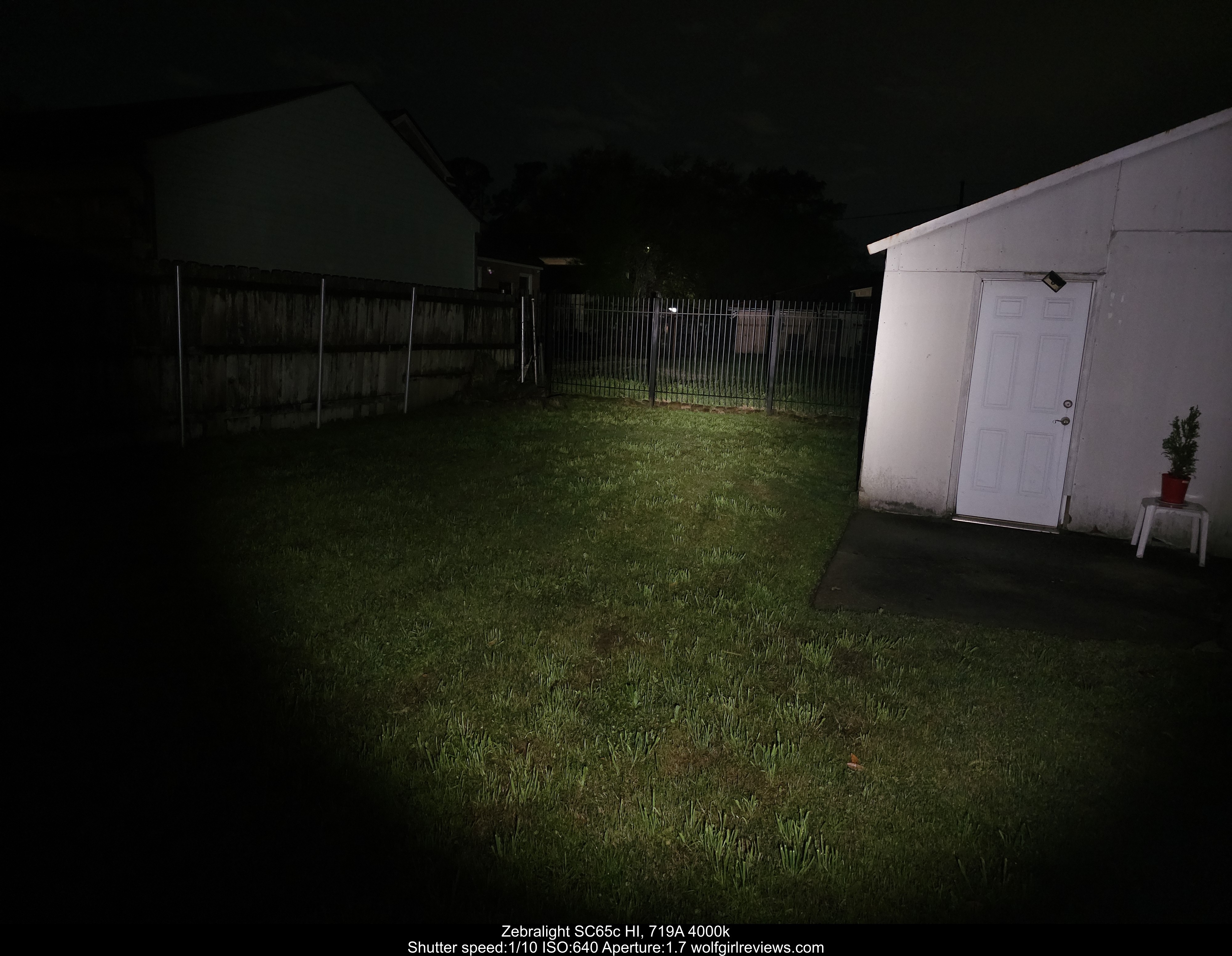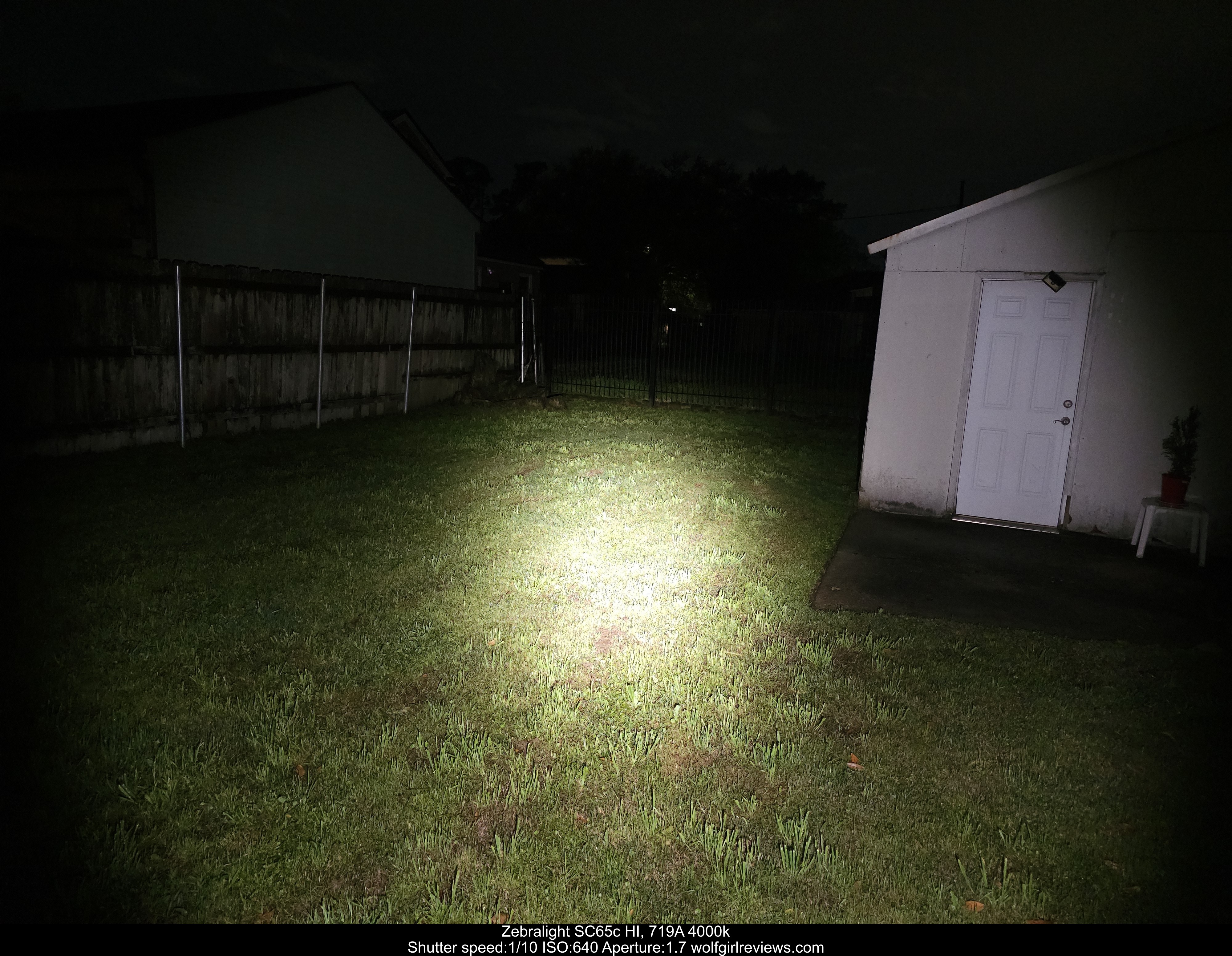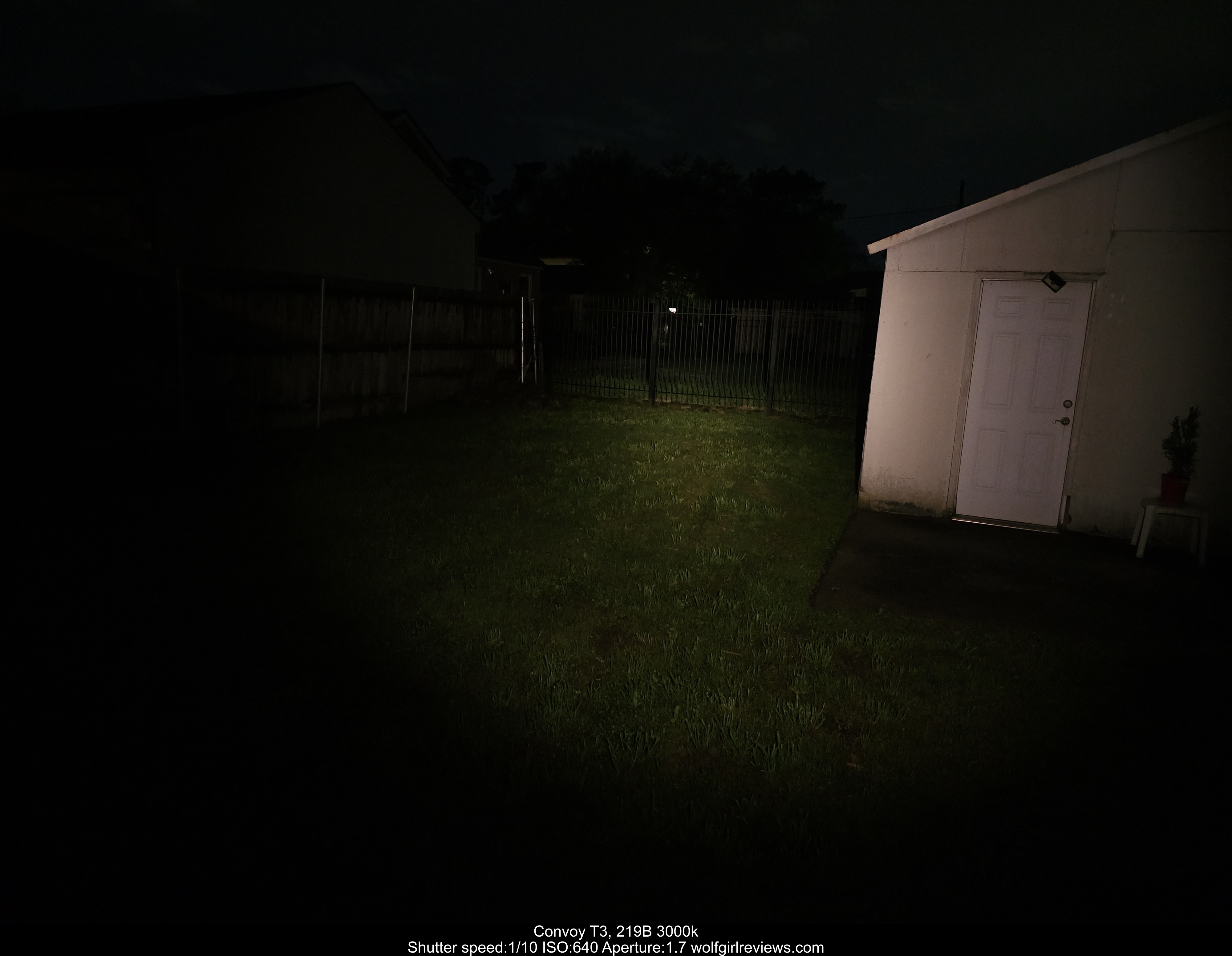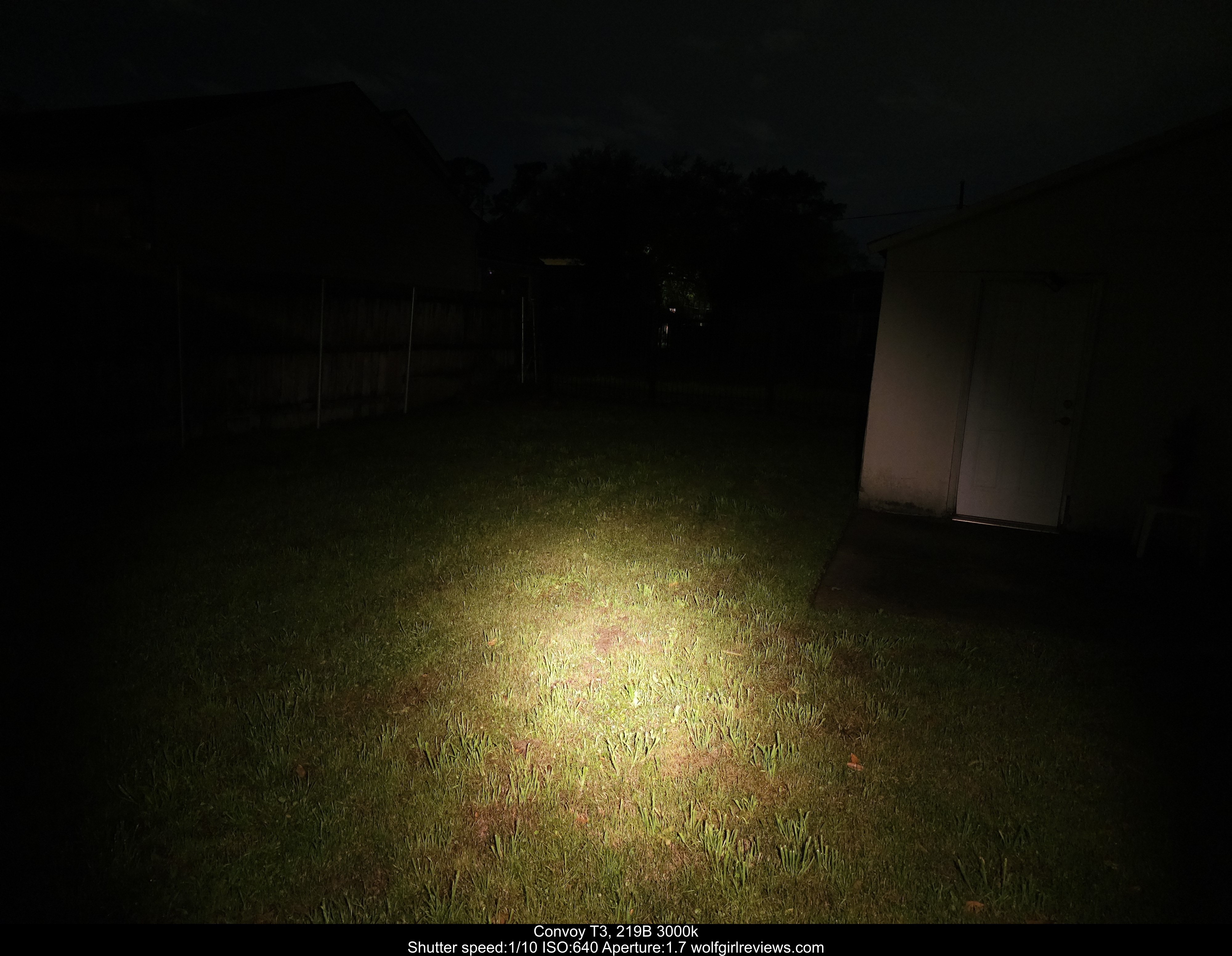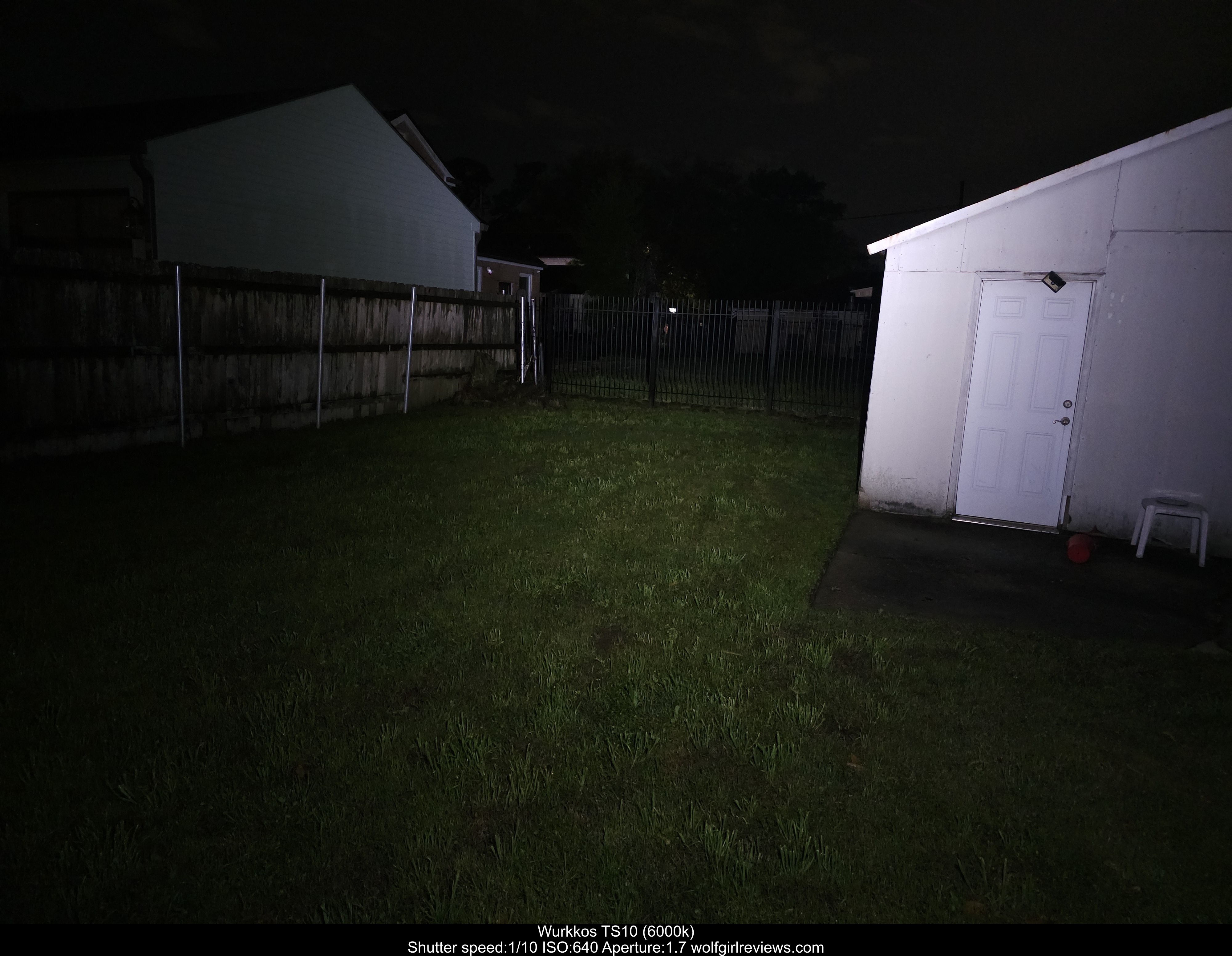"Nice optic, less nice LED. I think there's a saying about that..."
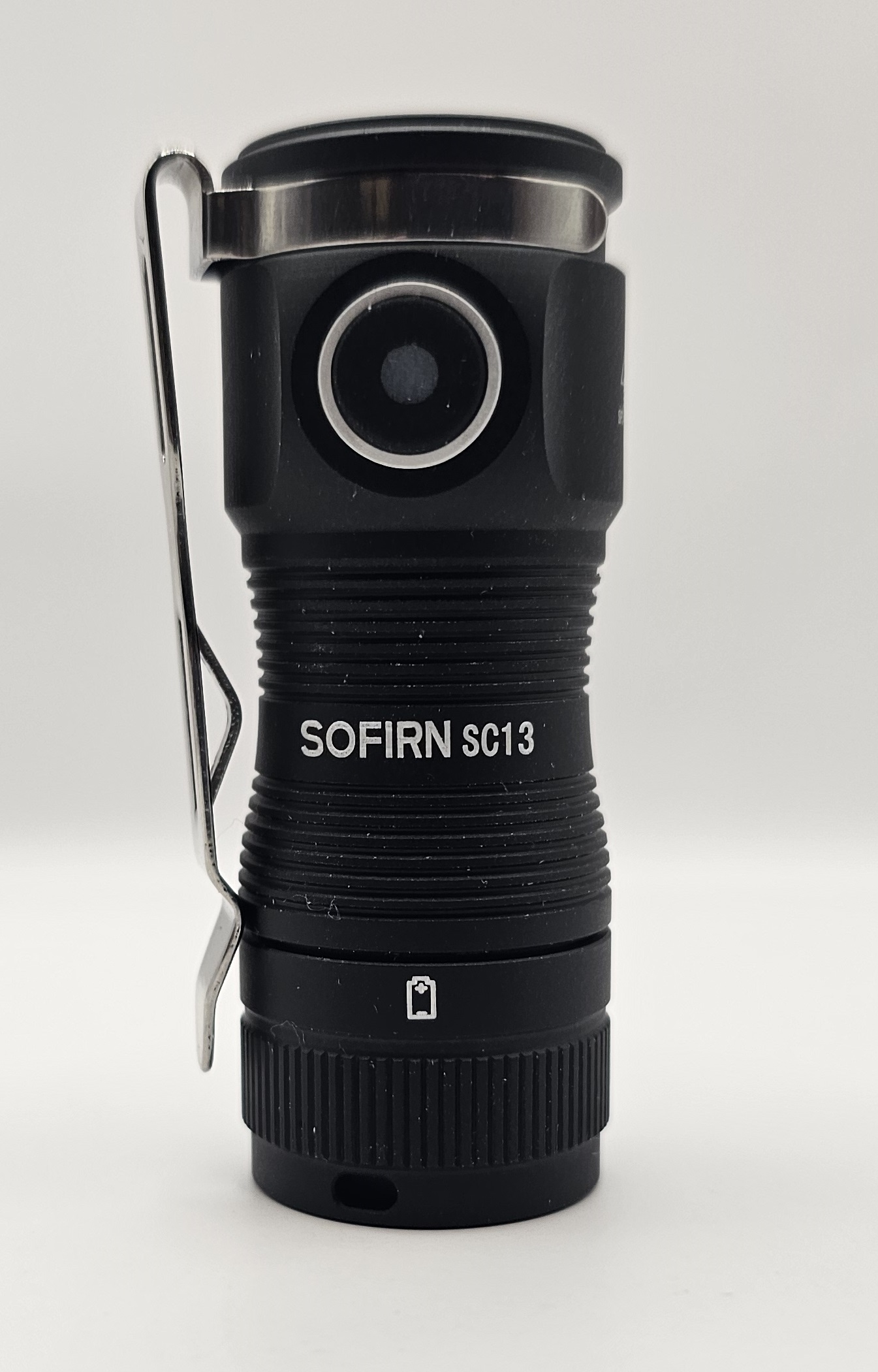 The Sofirn SC13 is a small 18350 light rated at 1300lm, using an SST40 and a Fresnel optic.
The Sofirn SC13 is a small 18350 light rated at 1300lm, using an SST40 and a Fresnel optic.
Introduction, Background, and Official Specs
To most enthusiasts, Sofirn need no introduction, having a long history of lights focused around value for money and catering to everyone from casual users to enthusiasts. The SC13 seems to be a smaller counterpart to the SC29 I reviewed last week, targeted towards the mid-market "small EDC" category. The SC13 features a Fresnel optic, designed to have the effect of a larger optic within a smaller space than a conventional shape.
Official specs:
| Parameter | Official Value | Measured |
|---|---|---|
| Output (turbo) | 1,300 lm | 1,361 lm |
| Runtime (turbo) | 1 hour 20 mins | 1 hour 29 mins ANSI FL1; 1 hour 47 mins to <1 lm |
| Intensity (turbo) | 217 m / 11,750 cd | 13,632 cd (233.5 m) |
| Output (high) | 500 lm | 531 lm |
| Runtime (high) | 1 hour 30 min | 1 hour 9 mins ANSI FL1; 1 hour 25 mins to <1 lm |
| Intensity (high) | 131 m / 4,267 cd | 3,856 cd (124.1 m) |
| Output (medium) | 150 lm | 172 lm |
| Runtime (medium) | 3 hours 30 mins | 3 hours 50 mins ANSI FL1; 5 hours 7 mins to <1lm |
| Intensity (medium) | 70 m / 1,242 cd | 2,016 cd (89.8 m) |
| Output (low) | 10 lm | 8 lm |
| Runtime (low) | 17 hours 36 min | |
| Intensity (low) | 18 m / 81 cd | |
| Output (moon) | 1 lm | <1 lm |
| Runtime (moon) | 100 hours | |
| Intensity (moon) | 6 m / 9 cd | |
| IP rating | IP68 | |
| Impact resistance | 1 m (3.28 ft) | |
| Weight (without battery) | 40 g | 38.8 g |
| Weight (with included battery) | 61.4 g | |
| Head diameter | 28.5 mm | 27.6mm switch to charging port, 25.0 mm narrowest point |
| Length | 2.54 inches (64.5 mm) | 65.0 mm |
| Body diameter | 21.3mm (narrowest point) | |
| Tailcap diameter | 24.4 mm |
For runtime testing, I give two figures when possible. The ANSI FL1 runtime is calculated by when the light drops below 10% of initial output. I also attempt to run the light past this to find the point where it switches off automatically if possible. Many lights will run at 1 lumen of less for an extended time before powering off, and with these lights I note my observations on when the runtime test was terminated, and may terminate tests at this point as my current measuring setup has a minimum of 1 lumen. For testing of output, my acceptable margin of error is between 5% and 15%, with margin increasing with output.
I was sent this light for free by Sofirn in exchange for a review. I am not receiving any commission for sales, and am giving my honest opinion without holding back on any negative experiences or overstating any positive. I may use affiliate links to Amazon or similar sites for things such as measuring equipment I use, but do not otherwise have any related interest in anything I mention.
First Impressions, Physical Design, and Build Quality
The SC13 uses Sofirn's slightly older style of packaging, a relatively plain brown cardboard box. Inside, the SC13 is protected in bubble wrap, and the included accessories are loose in the box, with a USB A-C cable, a pocket clip, and a lanyard and two spare o-rings in a bag. The clip is the type that snaps into a groove on the head, just below the bezel, allowing it to only be used in a head-up position. The relatively short distance to the top of the bezel means the SC13 rides relatively low in a pocket, and overall the clip felt securely enough attached, although it did rotate relatively freely, so will likely scratch the finish if it is installed. When in use, the clip's pinch point is against a smooth part of the tube, preventing any tendencies to wear out pockets.
Much like the SC29, the key unique feature of the SC13 is its optic. This is a Fresnel-type design, used to achieve the effect of a larger and deeper optic in a minimum of space. In this respect, the SC13 is very well designed, and this is one of the shorter 18350 lights I have seen. The optic is designed to be throwy, with usable spill, although throw is still ultimately limited by the length of the head.
The SC13 is a unibody design and so does not have the head as a distinct separate piece; instead, it smoothly blends into the battery tube, with raised and flattened facets on opposing sides, one of which holds the switch and the other the charging port. The switch is a relatively small diameter, with a large LED in the middle. Much like the SC29, this LED only seems to be capable of red and green, and is primarily used as both a battery and charging indicator. One feature that I like on the SC13 that is not on the SC29 is that the charging LED is visible through the main optic, similarly to aux LEDs, which makes it easier to see the charging status from a distance. A small amount of the main emitter's light is visible through the switch when the light is on as well, although this is not enough to be distracting or annoying and you really have to be looking for it to notice it. The switch LEDs also work as a battery indicator in the same way as the SC29, although this is of very little practical use as it will show as green all the way down until the battery is critically low. There is no option to use these LEDs as aux, even though the visibility of the LED through the optic certainly gives the impression of aux LEDs, and this would have been a nice addition.
The SC13 does technically have a separate bezel, which appears to be press-fit into the very top of the head, with a glass lens covering the optic, with what appears to be a light green AR coating, although the properties of the optic make it relatively hard to observe with direct light. The "HOT" symbol and the light's serial number are printed on one side of the head. The USB port is covered by a round rubber flap, which feels like it provides an adequate seal when pressed into the charging port's cavity, but the rubber tab on the end sticks out past this and can be noticed with the hand. Sofirn rate the SC13 as IP68, or for 1m depth. This is not a light I would deliberately take into water due to the charging port, and I did not get a chance to test it in the rain, but the seal of the flap makes me confident it would almost certainly survive at least a brief drop into water. The charging port cover does feel similar to the switch at a light touch, although when applying any force then it does become obvious which is which, with the switch having a relatively stiff and clicky action. Compared to the SC29, the SC13's switch is about half the size, protrudes more, has a slightly shorter travel and firmer click action, and a larger LED. Anti-roll protection is primarily provided by the two flattened areas of the head if the pocket clip is not installed, and is sufficient to stop it rolling under most realistic scenarios given its light weight.
The body tube features circular knurling for grip, with a smooth section in the middle, where "SOFIRN SC13" is printed on the front, and regulatory markings on the back. On the tailcap, there is a symbol to show battery polarity, and the tailcap has a ring of vertical reeding for grip. A lanyard hole is present below this and extends through the bottom surface of the tailcap - much like the SC29, this means installing the lanyard will compromise stability when tailstanding - although this is less of an issue in the SC13 as a much smaller and lighter light, this is still poor attention to detail when the lanyard hole can be cut into the side of the tailcap instead. The tailcap contains a magnet - this is a relatively low-strength magnet and is able to hold the SC13 on vertical metal surfaces, but it is not strong enough to be used to pin a stack of paper to one. Inside the tailcap, the design appears to be the same as the SC29, with both the tailspring and magnet appearing to be glued in place, and I had enough difficulty in attempting to disassemble that I chose not to continue until after completing the review.
A Sofirn branded unprotected 1100mAh button-top 18350 battery is included, with a paper insulator for shipping. Inside the body tube, the driver can be seen, with a button to contact the battery, in addition to an exposed IC that is possibly the MCU. The negative current path is from the tailcap through the top edges of the body tube, where there are contact pads on each side of the driver. The SC13 also worked when tested with an unprotected flat top 18350, although a USB-C protected 18350 was too long.
The surface finish was perfect, with no imperfections, and a slight matte finish. It does not feel like HA III, but the process that Sofirn are using does feel consistent and stood up well to carrying.
Sofirn's warranty is described on their website and is covered via the seller for the first 30 days, then free replacement from Sofirn for the first 12 months, or 6 months for defective batteries.
Size Comparison
I took comparison photos of the SC13 as well as several other small lights.
- Sofirn SC13
- Wurkkos TS10
- Sofirn SP10 Pro
- Convoy T3
- Emisar D4v2 (18650 and 18350 tubes)
- Lumintop FW3A (18650 and 18350 tubes)
- Lumintop GT Nano Pro
- Skilhunt Mix-7
- Zebralight SC65c HI
User Interface
The SC13's user interface is the same as the SC29's.
| State | Action | Effect |
|---|---|---|
| Off | 1C | On (mode memory) |
| Off | 1H | Moon |
| Off | 2C | Turbo |
| Off | 3C | Lockout |
| Off | 4+C | (Nothing) |
| On | 1C | Off |
| On | 2C | Turbo |
| On | 1H | Cycle brightness (stepped) |
| Turbo | 1C | Previous mode, see below |
| Turbo | 2C | Strobe |
| Moon | 1H | Exit moon to low |
| Moon | 2C | Turbo |
| Lockout | 1C | Blink twice |
| Lockout | 1H | Momentary moon |
| Lockout | 3C | Unlock (to on, mode memory) |
This is a relatively simple stepped-only UI, which follows some standard conventions, but is still somewhat bare in features. There is a lockout mode, but it is on 3C rather than the 4C that is more common. There is no battery check mode or configurability of any sort, and moonlight mode is only accessible from off, combined with the inability to adjust brightness downwards, plus forced mode memory always being on, means you always have to go through either high or off to go from medium to low. With only three 'normal' modes, this is at least less annoying than having to cycle through many high modes, but is still enough that an unexpected moment of high output could ruin night vision for the unprepared.
Turbo mode has some unique, and in my opinion undesirable behaviour - if you enter turbo directly with 2C from off, 1C will exit turbo and switch the light off, as is true with most e-switch lights, however, if you entered turbo with 2C when the light was already on, 1C will exit back to the prior level but not turn the light off. Normally, 2C is used to exit turbo mode without switching the light off, but in the UI, strobe mode is not directly accessible from off or the standard levels, but instead is from 2C while already in turbo. Personally, I find hidden strobes preferable in general, and turbo is a decent place to hide it, as if strobe is to be used in a self-defence scenario then going to turbo first before using strobe is a reasonable assumption, while accidentally entering 3C and getting strobe directly from off tends to lend itself to accidents easily in my opinion, but I do instead often find myself frustrated that I can not switch the light directly off from turbo.
A lockout mode is present, but on 3C instead of the more familiar 4C - overall, I am happy that lockout was included as some very basic e-switch UIs do not, but I would have preferred lockout mode on 4C like the majority of lights as this is that is in my and most other enthusiasts' muscle memory, although it could be argued that this light is aimed more towards nonenthusiasts overall where having a set of button shortcuts with no gaps is arguably an advantage (although equally, it means there is a leaning curve if graduating to more advanced UIs).
I'd have preferred to have seen a battery check mode on 3C, even if just a simple 4 or 5 "bar" mode such as Zebralight or Convoy's, and lockout on 4C. One positive here and criticism I have of the UIs on some of Sofirn's other non-Anduril lights is extremely short forced autolock timers, which is thankfully not the case here, as there is no autolock of any type. Actuation in a pocket is possible with the large switch, and the SC29 may get hot enough to be uncomfortable but is less likely to actually burn fabrics than some other higher powered lights, especially since, as discussed in performance then the stepdown from turbo is very rapid, but overall this is still a light I would recommend carrying while locked only. The switch's LED is solely used as a battery indicator when powering the light on (similarly to Acebeam's battery indicator, this is a simple two-colour LED where green means "anywhere from full to low" and red means "critically low", and can not be used as an indicator for location or to show battery status at any time other than when the SC29 is first switched on.
| What it gets right | What it gets wrong |
|---|---|
| Gets the basics right - 1C on/off, 1H to change brightness | No ramping UI, stepped only |
| Strobe mode is reasonably accessible without being easy to accidentally activate | No battery check mode or control over switch LED |
| Electronic lockout mode without forced automatic lockout | Some button shortcuts are counterintuitive |
| Mode spacing is decent for so few modes | No way to go backwards through modes other than via off and moon |
Using the Light
The SC13 is bright for its size, with an output on turbo with a fresh battery of 1300lm. Output is generally a secondary consideration in most dedicated 18350 lights, with the highest performing lights in this size usually being lights designed for 18650 and with an optional short tube fitted, which tend to be enthusiast-oriented, such as those from Emisar and Lumintop. The SC13 is not oriented towards enthusiasts, but instead towards more casual users, with the same interface as the SC29 I reviewed last week. As UIs go, it is reasonable for a non-ramping e-switch UI, although enthusiasts will hit a few annoyances, it is good for many other users. The SC13 makes a good spare light to keep around the house as well, as the magnetic tailcap allows a few convenient placement options. 1300 lm is a respectable output for the size and its lack of aspiration for "enthusiast light" status, although that gets me onto one of the negatives.
For the SC13, Sofirn only offer one emitter option, an SST40, with a CCT quoted as 6000-6500k. This emitter is a controversial choice - the SST40 is one of the least popular of the common Luminus emitters, having mostly fallen out of favour when compared to the SFT40, its younger, hotter sibling. Sofirn have used the SST40 in multiple lights, so this was overall an expected move, but many enthusiasts would have been happier to see an SFT40 instead.
The SST40 is a domed emitter, essentially a scaled up SST20, compared to the domeless SFT40, but generally has a more positive DUV (representing a greener tint) as well as tint shift in its beam - the SFT40 is intended as a throw LED counterpart to the SST40, with the latter being the floodier and higher output LED, but in practice, the SFT40 can be driven much harder before failing, resulting in a higher maximum output when overdriven. In this case, the SST40 is not driven particularly hard, resulting in a higher lumen output, but the subjective 2quality of the SST40 is generally considered worse, usually with some tint shift being evident in the beam, as well as a less neutral tint that often has hints of green. Additionally, the SFT40 is available in a high CRI version as well as a broader range of CCTs, but Sofirn have opted to only offer the SC13 in the 6000k version. For most non-enthusiasts, this is likely not a problem as 6500k is on the low end of the LEDs used by many cheaper lights, but enthusiasts would probably have preferred to see at least a neutral option. More on the beam in Driver and Emitters.
When carrying the SC13, the main impression of is how small this light is. I'm usually carrying two or three larger lights so am used to that, but the SC13 is unobtrusive and adds very little bulk to someone who may not be able or willing to carry a larger light. The pocket clip feels relatively secure, although as is often true with this type, over time it will rotate around the bezel and cause scratches. As previously mentioned, this clip only supports head-up carry, which while I favour, I gather seems to be slightly less preferred overall by many people. As I discuss in Moddability, there is a reasonably large number of clips available with potential to fit the SC13 that include reversible clips. One thing that the SC13's clip design does allow is use as a hat light, which works well with its short length and light weight.
The SC13 has a little less output than many lights I normally carry, but is still sufficient for general use by most people - as much as I enjoy using thousands of lumens, a few hundred is more than enough for something like finding your keys, seeing where you are going on a walking path, or looking inside a bag or under a table. One thing I would consider though is that you do need to use turbo to get any real throw, so if being used for something like dog walking, you will want to manage your battery carefully as each successive use will cause overall performance to drop, and in my opinion the SC13 does not communicate battery status well to the user. The moon mode is around 1lm and may be a little bright for tasks demanding very low light like avoiding waking up someone who is asleep, but is still sufficiently low to preserve night vision well.
When in use on turbo, the SC13 stayed at a comfortable temperature. From room temperature, the SC13's temperature initially stabilised at 44.5 degrees Celsius (112 Fahrenheit) after 1 minute and 15 seconds on turbo; after the light finished stepping down to a thermally sustainable level, temperature fluctuated a little more with a high of 47 degrees.
Driver and Emitters
As the SC13 was released at around the same time as the SC29 and uses the same user interface, it is not a surprise that it also appears to be based on the same driver design. This is a linear regulator, although in the SC13, the much smaller battery has a harder drop off at low voltages, lacking some of the extremely long low-battery runtimes seen on the SC29.
Although many enthusiasts will dislike the choice of emitter, it is possibly the best beam I have seen from an SST40 light, although overall it still feels like a poor use of the unique optic when compared to other LEDs with the same footprint such as the SFT40 or even XHP50. Compared to the other SST40 lights I own, the SC13 has similar throw to my SC31 Pro, but with a significantly nicer beam up close, with less evidence of tint shift/, smooth spill, and fewer beam artefacts than the SC31 Pro's smooth reflector overall, although when used on high settings up close, rings are visible in the spill from the optic. In addition, this SFT40 seemed to have a reasonable binning, with positive DUV only on moon, with DUV becoming more negative at higher levels. The SST40 was likely chosen for high output, as the domed emitter is marginally more efficient than the SFT40, and this causes the beam quality to suffer - the SC13's performance is well within the capability of an SFT40, but this would have necessitated a more powerful driver and potentially battery. In my opinion, the optic has a lot of potential and an SFT40 combined with a higher drain 18350 would have been a significant improvement.
For the average non-enthusiast user, the SC13's beam is more likely to be appreciated, as it is reasonably pleasant once enthusiast expectations have been addressed, with a significantly nicer beam quality than other lights with the SST40 that I have tested, as the optic does a good job of diffusing the beam enough that while there is still some tint shift present, it is mostly limited to a relatively small corona around the hotspot and not present to any significant degree in the spill, and there are no artifacts visible with the entire beam being consistent as the light is rotated in my hand. The Fresnel construction of the optic likely helps a lot in this, as this is a method of fitting a larger (deeper) lens of a more traditional type into as little space as possible. Fresnel lenses are perhaps best known for high intensity beams, but can be used to reproduce a lens of different beam angles. Here, it seems like the SC13's lens is designed with a relatively throwy beam profile in the centre, to offset the SFT40's floodiness, with a relatively wide and even spill due to the SST40's nature as a high output flood LED.
The packaging states 6000-6500k for the LED's CCT, so much like the SC29, this is likely an LED with a relatively wide binning, so my results may not reflect all examples. I found the CCT to be significantly lower than spec, with 5439k at low and 5800k at high, although this may not be typical, and similarly with the DUV, I can not guarantee that other examples are not more positive.
I measured the SC13's CCT and CRI with a Colormunki Photo and ArgyllCMS.
CRI and tint
Power and Charging
The SC13 has built in USB-C charging, with a circular rubber port cover on the opposite side of the head from the switch. The fit into the cutout is average, not too tight but not inspiring excessive confidence in its water resistance - if this light is used in heavy rain or takes a quick dip into water, I would definitely make sure the port is dry before charging.
The switch LED turns red when charging and green when the charge is completed. The SC29 does not feature a powerbank mode, and nothing happened when connecting it to various USB devices. It never overcharged the battery, each time I tested it terminating at 4.15 or 4.16V.
Charging data was collected using rd-usb with an RDTech TC66C (info, Amazon (US).
The SC13's manual indicates that low voltage cutoff is at 2.7V, and in my testing I found this accurate. When the light did cut off from low voltage, I was able to instantly switch the light back on and even enter turbo, although LVP would cut in again relatively quickly afterwards.
Moddability
As previously mentioned, this clip only supports head-up carry, which while I favour, I gather seems to be slightly less preferred overall by many people. The diameter of the SC13's clip groove is 22.5 mm, so there are possibly other reversible clips that could fit. Clips suitable for the popular Wurkkos TS10 may be possible with some modification, which has a diameter of 19.5mm.
The SC13 does appear to have a bezel, although it is press-fit into the head and can not be easily removed. Due to the unibody design, the driver can not be easily accessed and removal would likely require desoldering the LED wires. Much like the SC29, the tailspring and the magnet behind it both appear to be glued in place, but could most likely be removed with some solvent and persistence.
Performance
All lumen measurements taken using a 4.5 inch Texas Ace lumen tube. Candela measurements were performed indoors at a distance of 4m, using a UNI-T UT383BT datalogging luxmeter.
Runtime tests were performed using the lumen tube's HS1010A luxmeter, which the tube is calibrated for, with data recorded via taking a video, exporting the individual frames using ffmpeg, and parsing the value on the luxmeter's display at the appropriate frame for each measurement. I logged the value every second for the first 90 seconds, then every 5 seconds up to 30 minutes, every 30 seconds up to 3 hours, then every minute past that point. The SC29 maintained a stable output when not throttling thermally, with no sharp drops for LVP when running down from a higher level. The switch LED started blinking red when the light dropped to around 10lm with the battery nearly depleted, but it was capable of running for an extended time in this state before finally cutting off completely from 1lm with the battery at ~2.75V.
Specs
Official output spec is 2,300 lm on turbo, and candela spec is 11,750 cd. As the performance of the SC13 is not exceptionally high, a 5% margin of error on all measurements is reasonable; in general Sofirn's performance figures tend to be realistic.
| Spec | Measured | |||||
| Level | Output (spec) |
Intensity (spec) |
Runtime (spec) |
Output (measured) |
Intensity (measured) |
Runtime (measured) |
| Turbo | 1,300 lm | 11,750 cd | 1 hour 30 min | 1,308 lm | 13,632 cd (233.5 m) | 1 hour 29 mins ANSI FL1; 1 hour 47 mins to <1 lm |
| High | 500 lm | 4,267 cd | 1 hour 30 min | 531 lm | 3,856 cd (124.1 m) | 1 hour 9 mins ANSI FL1; 1 hour 25 mins to <1 lm |
| Medium | 150 lm | 1,242 cd | 3 hours 30 mins | 172 lm | 2,016 cd (89.8 m) | 3 hours 50 mins ANSI FL1; 5 hours 7 mins to <1lm |
| Low | 10 lm | 81 cd | 17 hours 36 min | 8 lm | ||
| Moon | 1 lm | 9 cd | 100 hours | 1 lm | ||
Output and Throw
| Mode | Peak output | Output after 30s | Output after 1 minute | Output after 90s | Output after 5 minutes | Output after 15 minutes |
|---|---|---|---|---|---|---|
| Turbo | 1,361 lm | 1,259 lm | 808 lm | 324 lm | 299 lm | |
| High | 531 lm | 505 lm | 498 lm | 497 lm | 482 lm | 428 lm |
| Medium | 172 lm | 167 lm | 166 lm | 164 lm | 158 lm | |
| Low | 8 lm | 8 lm | 8 lm | 8 lm | 8 lm | |
| Moon | 1 lm | 1 lm | 1 lm | 1 lm | 1 lm |
| Mode | Peak candela | Candela after 30s | Candela after 1 minute | Candela after 5 minutes |
|---|---|---|---|---|
| Turbo | 13,632 cd (233.5 m) | 12,320 cd (222 m) | 12,688 cd (225.3 m) | 3,424 cd (117.2 m) |
| High | 3,856 cd (124.1 m) | 3,680 cd (121.3 m) | 3,648 cd (120.8 m) | 3,472 cd (117.8 m) |
| Medium | 2,016 cd (89.8 m) | 2,000 cd (89.4 m) | 1,984 cd (89 m) | 1,904 cd (87.2 m) |
Much like the SC29, overall absolute output is reasonable for a small light. Runtimes suffer due to the 18350 battery and low thermal mass.
Runtime
| Mode | Runtime |
|---|---|
| Turbo | 1 hour 29 mins ANSI FL1; 1 hour 47 mins to <1 lm |
| High | 1 hour 9 mins ANSI FL1; 1 hour 25 mins to <1 lm |
| Medium | 3 hours 50 mins ANSI FL1; 5 hours 7 mins to <1lm |
Performance Overview
Again. similarly to the SC29, the SC13 comes very close to spec at start up, but has less good sustained output with output dropping quickly both due to voltage sag from the battery and thermal regulation. Even the 18350 battery will still provide usable light for a reasonably long time on moon or low, although if using the SC13 more intensely then performance will soon start to suffer with use of higher levels.
The Fresnel optic does provide excellent throw performance for such a small light, coming very close to the larger and deeper optic on the SC29.
Beamshots
Lights used:
- Sofirn SC13
- Emisar D4v2 (W2, boost driver, measured at 2290 lm)
- Lumintop FW3A (XP-L HI 6500k, measured at 1900 lm)
- Lumintop GT Nano Pro (SST20 6500k, measured at 1860 lm)
- Noctigon KR4 (519A 4500k, measured at 4400 lm)
- Skilhunt/Eskte Mix-7 (cool white version, measured at 2500 lm)
- Zebralight SC65c HI (719A 4000k, pre-revision driver, measured at 760 lm)
- Loop SK03 (519A 4500k, measured at 820 lm)
- Sofirn SP10 Pro (LH351D 5000k, measured at 790 lm)
- Sofirn SC31 Pro (SST40 6500k, measured at 1950 lm)
- Convoy T3 (219B 3000k, measured at 278 lm)
- Wurkkos TS10 (6000k, measured at 900 lm)
SC13
Comparison Beamshots
Competitors
Sofirn SC31 Pro - The SC31 Pro also uses an SST40, although with an 18650 battery, this is a much larger light and gets more output from it. The SC13 is about half the length of the SC31, with a similar width, and lower overall output but with comparable throw. My SC13 has a much nicer example of the SST40 than my SC31 Pro, but this may vary. The key difference other than size and battery is in user interface - the SC31 Pro runs anduril, while the SC13 has a much simpler interface. In all other respects than interface and UI, the SC13 is a better SST40 light.
Emisar D4v2/Lumintop FW3A - The D4v2 is perhaps the best performing 18350 light available, with both linear+FET and boost driver options, and a huge selection of LEDs, and again running Anduril. This or the FW3 is likely to be the alternative to the SC13 enthusiasts are more likely to be interested in. The FW3A is similar to the D4v2, but harder to find, with fewer emitter options, slightly smaller and lighter, a much older and non-updatable version of anduril, and with a tailswitch instead of the sideswitch.
Lumintop GT Nano Pro - Something of an odd choice as a competitor, the GT Nano Pro excels at one thing - getting as much output as possible from as small a light as possible. Obviously, this leads to compromises - there is no built in charging, the user interface is bad, runtimes are very short, but if you want a lot of lumens from a tiny light, this is an excellent choice.
Skilhunt Mix-7 - The Mix-7 is a little longer than the SC13 but overall still deserves to be in the same size class. The mix-7 has higher output with either cool white or optional high CRI LEDs, and in addition, has RGB and UV, and a more efficient driver. The Mix-7's user interface is less conventional but still usable. If the SC13's small form factor is appealing but a simpler UI than anduril is desired, the Mix-7 is a reasonable choice, although more expensive than the SC13.
Wurkkos TS10 - If you want a lot of output in a small Anduril light, it doesn't get much better than the Wurkkos TS10. Excellent value for money, and capable of outperforming the SC13 with a high drain battery (the TS10 I tested in this review was using the stock Wurkkos battery) and high CRI. Lack of built in charging may be a negative.
Convoy S2+ - The S2+ with an 18350 tube is a viable alternative to the SC13 - although somewhat larger and without USB charging, enthusiasts are likely to appreciate its wide selection of LED options. The S2+ uses the standard Convoy reverse clicky UI, which is very different to the SC13's e-switch UI, and it is a matter of personal taste which someone might prefer.
Final Thoughts and Score
| Category | Score | Comments |
|---|---|---|
| Looks | 7/10 | The SC13 does well for a small light, with an eye-catching design that is ergonomically pleasant to hold. The Fresnel optic draws the eye and is a break from the more common reflectors and standard TIRs used in many small lights. The charging port blends well into the body when not in use, and the charging LED's visibility through the optic is a nice touch. |
| Quality | 7/10 | The fit and finish are good with no obvious flaws, and held up well to carry - even installing and removing the pocket clip did not damage the finish with some care taken, although extended use of the clip is likely to. When in use, the clip's pinch point is against a smooth part of the tube, preventing any tendencies to wear out pockets. The switch has an excellent feel (I would argue nicer than the SC29's), and there were no problems with the light's operation or charging. |
| User interface | 6/10 | It's a user interface with nothing immediately irritating that gets the basics right, although I do dislike the lack of a smooth ramp mode and the ability to cycle levels downwards without first either switching the light off or looping through high. I do appreciate how strobe is thoughtfully hidden so it is still accessible in an emergency situation, but not too accessible so someone would accidentally strobe themselves with it. I kept consistently forgetting lockout was on 3C instead of 4C, and it would not have been hard to have 4C also activate lockout if Sofirn were set on having it on 3C, although this tends to go against the more common convention of 4C. The lack of a battery check mode is a major annoyance, especially as Sofirn have done an Acebeam here in having a battery indicator that stays green until the light is well into "critically low battery" levels, then turns red... |
| Performance (absolute) | 6/10 | 1300 lm is reasonable for an 18350 light, and the SC13 meets spec. |
| Performance (sustained) | 5/10 | The SC13 steps down very quickly even when considering its battery size, stabilising at around 300 lm. In addition, high mode actually has shorter runtime than starting from turbo, due to being able to spend longer in the 300-500lm range draining the small battery more quickly. Much like the SC29, the SC13 runs for a long time on a very low mode. |
| Moddability | 3/10 | The press-fit bezel seems very difficult to remove, and may be glued. This is not a light that would be easy to emitter swap, and other modding opportunities are relatively few. The tailcap looks like the magnet could be either removed or replaced by a stronger one without too much difficultly, although my initial attempts to remove the spring failed and led me to give up since I did not want to damage the tailspring before I had finished testing. |
| Practicality | 6/10 | For a small light that can be kept around without much thought until needed, the SC13 is certainly useful, however, it also falls into an area of not being exceptionally good at any one thing - performance and runtime are both respectable but nothing special, and the lack of a high CRI LED option and simple user interface matter less with non-enthusiasts, but limit its appeal to people who would rather opt for a lower output light with an LED such as 519A. |
| Value | 7/10 | $38 full price is reasonable for a small high output light, being less than higher performing competitors. With a battery included and no need for an external charger, this places it well within a reasonable range for a cheap gift, or even for a spare light to keep in a convenient location. Sofirn do have very regular sales, and at the time of writing, it is on sale for $30. |
| Fun | 6/10 | As an enthusiast, I have a lot of choice for high output lights, but it is worth considering that not too long ago, 18350 lights with high output were mostly the domain of more enthusiast-oriented options like the Wurkkos TS10. The SC13 still has enough output for its size to impress people, and while the LED is not going to win any awards from /r/flashlight, my particular example was at least reasonable. |
| Overall | 7/10 | If the SC29 is appealing but too large, the SC13 is a smaller alternative that is worth considering. It does everything trhat 95% of people will need from a small EDC light, and while the emitter is not the most ideal choice, Sofirn have gone to some effort with the optic and few people other than those who can't stand cool CCTs in any light will at least find the beam reasonable for what it is |
Much like the SC29, I'm not specifically the target market for this light, but overall, it combines choices that were made with a mainstream product in mind with general day-to-day usability, and if space is limited, the performance is reasonably good for at least the first minute before thermal regulation kicks in. Overall, this is a good light to give to someone who insists they don't need one, and I would certainly prefer to use it over a phone.
The SC29 is available from sofirnlight.com, Sofirn's official AE store, or on Amazon. At the time of release of this review, the SC13 is on sale for $31 on sofirnlight.com with an additional coupon available, and for $18 on AliExpress as part of Sofirn's Anniversary Sale.
Thanks for reading again. Hopefully I will be getting some pace back into reviewing in the near future, I have a couple in my backlog but right now am mostly limited by time and other projects competing for my attention, but hopefully in a month or so I will be able to at least collect data faster which will improve my reviewing pace and let me get to a few lights I've been meaning to review for some time now. Hopefully it was worth the wait. As always, feedback is welcome - I am active on BLF or Reddit, both on /r/flashlight and other specific subreddits, and have started my own subreddit for review content at /r/WolfgirlReviews.
>> Home





















